遗传算法MATLAB仿真程序
用MATLAB实现遗传算法程序
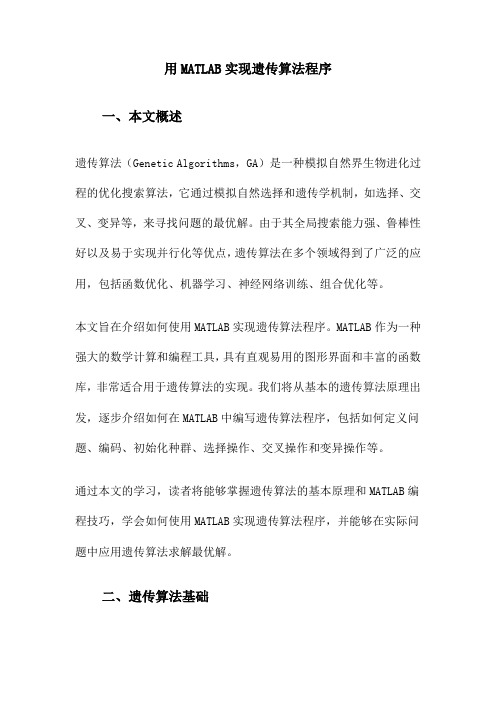
用MATLAB实现遗传算法程序一、本文概述遗传算法(Genetic Algorithms,GA)是一种模拟自然界生物进化过程的优化搜索算法,它通过模拟自然选择和遗传学机制,如选择、交叉、变异等,来寻找问题的最优解。
由于其全局搜索能力强、鲁棒性好以及易于实现并行化等优点,遗传算法在多个领域得到了广泛的应用,包括函数优化、机器学习、神经网络训练、组合优化等。
本文旨在介绍如何使用MATLAB实现遗传算法程序。
MATLAB作为一种强大的数学计算和编程工具,具有直观易用的图形界面和丰富的函数库,非常适合用于遗传算法的实现。
我们将从基本的遗传算法原理出发,逐步介绍如何在MATLAB中编写遗传算法程序,包括如何定义问题、编码、初始化种群、选择操作、交叉操作和变异操作等。
通过本文的学习,读者将能够掌握遗传算法的基本原理和MATLAB编程技巧,学会如何使用MATLAB实现遗传算法程序,并能够在实际问题中应用遗传算法求解最优解。
二、遗传算法基础遗传算法(Genetic Algorithm,GA)是一种模拟自然选择和遗传学机制的优化搜索算法。
它借鉴了生物进化中的遗传、交叉、变异等机制,通过模拟这些自然过程来寻找问题的最优解。
遗传算法的核心思想是将问题的解表示为“染色体”,即一组编码,然后通过模拟自然选择、交叉和变异等过程,逐步迭代搜索出最优解。
在遗传算法中,通常将问题的解表示为一个二进制字符串,每个字符串代表一个个体(Individual)。
每个个体都有一定的适应度(Fitness),适应度越高的个体在下一代中生存下来的概率越大。
通过选择(Selection)、交叉(Crossover)和变异(Mutation)等操作,生成新一代的个体,并重复这一过程,直到找到满足条件的最优解或达到预定的迭代次数。
选择操作是根据个体的适应度,选择出适应度较高的个体作为父母,参与下一代的生成。
常见的选择算法有轮盘赌选择(Roulette Wheel Selection)、锦标赛选择(Tournament Selection)等。
毕业设计(论文)-基于matlab的遗传算法研究及仿真[管理资料]
![毕业设计(论文)-基于matlab的遗传算法研究及仿真[管理资料]](https://img.taocdn.com/s3/m/2477e5c383c4bb4cf6ecd1cf.png)
基于Matlab的遗传算法研究及仿真姓名:学号:学院:机电学院指导教师:日期:2016-7-20摘要本文首先介绍了遗传算法的基本思想、遗传算法的构成要素、遗传算法的特点、遗传算法的基本模型、遗传算法的应用情况及今后的研究方向等等的内容。
之后是基于Matlab 。
本人选择了函数优化这个应用领域,按照遗传算法的步骤,即编码、解码、计算适应度(函数值)、选择复制运算、交叉运算和变异运算,对函数进行求解最值。
第三部分:对遗传算法求函数最值问题的改进。
这部分主要针对本文第二部分进行改进,通过改变基本遗传算法运行参数值,如改变交叉概率Pc值和变异概率Pm值,从而使最优值更加接近相对标准下函数的最值。
关键词:遗传算法适应度交叉概率变异概率Study and Application of Genetic AlgorithmAbstract:Firstly,the outline of the Genetic Arithmetic,mainly introduced the Genetic Arithmetic’s mentality、elements、specialty、fundamental model、applied situation and direction of the following research and so on. Secondly,the problem of solving functions’ maximal and minimum value of the Genetic Arithmetic on the basic of Matlab . As a new optimized method,used widely in some aspects,such as computing and science、model identity、intelligence obstacles diagnoses,it is fit to solve the problems of complicated nonlinear and multidimensioned space to find out the optimal value,which applied widely in recent years. I choose functions perfecting and according to its steps : coding,decoding,working the adaptive degree (function value),selective reproductive operation,across operation,differentiation operation and working out the maximal and minimum value. Thirdly,betterment of using the Genetic Arithmetic to get functions’ maximal and minimum value. This part make use of method that changing the basal Genetic Arithmetic to make maximal and minimum value approaching the one that from opposite standard,such as a change of probability of across value Pc and differentiation value Pm.Key words: Genetic Algorithm; The adaptive degree; Probability of Crossover; Probability of Mutation1 前言生命科学与工程科学的相互交叉、相互渗透和相互促进是近代科学技术发展的一个显著特点,而遗传算法的蓬勃发展正体现了科学发展的这一特征和趋势。
遗传算法的MATLAB程序实例讲解学习
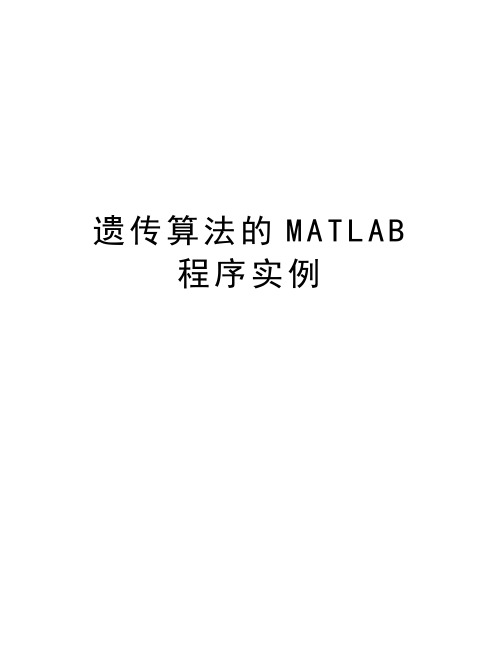
遗传算法的M A T L A B程序实例遗传算法的程序实例如求下列函数的最大值f(x)=10*sin(5x)+7*cos(4x) x∈[0,10]一、初始化(编码)initpop.m函数的功能是实现群体的初始化,popsize表示群体的大小,chromlength表示染色体的长度(二值数的长度),长度大小取决于变量的二进制编码的长度(在本例中取10位)。
代码:%Name: initpop.m%初始化function pop=initpop(popsize,chromlength)pop=round(rand(popsize,chromlength));% rand随机产生每个单元为 {0,1} 行数为popsize,列数为chromlength的矩阵,% roud对矩阵的每个单元进行圆整。
这样产生的初始种群。
二、计算目标函数值1、将二进制数转化为十进制数(1)代码:%Name: decodebinary.m%产生 [2^n 2^(n-1) ... 1] 的行向量,然后求和,将二进制转化为十进制function pop2=decodebinary(pop)[px,py]=size(pop); %求pop行和例数for i=1:pypop1(:,i)=2.^(py-1).*pop(:,i);py=py-1;endpop2=sum(pop1,2); %求pop1的每行之和2、将二进制编码转化为十进制数(2)decodechrom.m函数的功能是将染色体(或二进制编码)转换为十进制,参数spoint表示待解码的二进制串的起始位置。
(对于多个变量而言,如有两个变量,采用20为表示,每个变量10为,则第一个变量从1开始,另一个变量从11开始。
本例为1),参数1ength表示所截取的长度(本例为10)。
代码:%Name: decodechrom.m%将二进制编码转换成十进制function pop2=decodechrom(pop,spoint,length)pop1=pop(:,spoint:spoint+length-1);pop2=decodebinary(pop1);3、计算目标函数值calobjvalue.m函数的功能是实现目标函数的计算,其公式采用本文示例仿真,可根据不同优化问题予以修改。
遗传算法解决非线性规划问题的Matlab程序
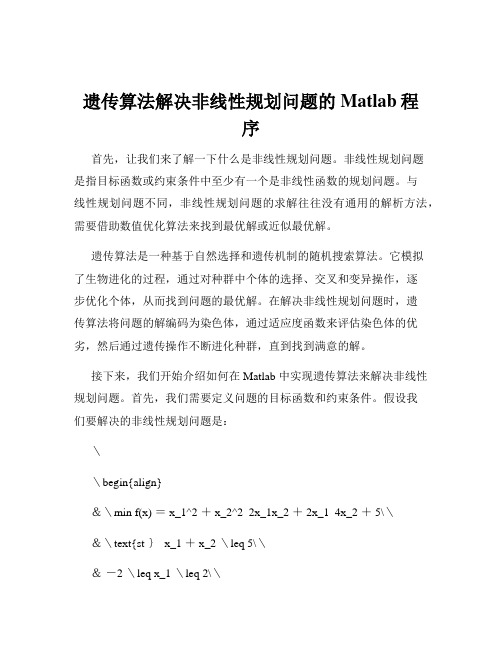
遗传算法解决非线性规划问题的Matlab程序首先,让我们来了解一下什么是非线性规划问题。
非线性规划问题是指目标函数或约束条件中至少有一个是非线性函数的规划问题。
与线性规划问题不同,非线性规划问题的求解往往没有通用的解析方法,需要借助数值优化算法来找到最优解或近似最优解。
遗传算法是一种基于自然选择和遗传机制的随机搜索算法。
它模拟了生物进化的过程,通过对种群中个体的选择、交叉和变异操作,逐步优化个体,从而找到问题的最优解。
在解决非线性规划问题时,遗传算法将问题的解编码为染色体,通过适应度函数来评估染色体的优劣,然后通过遗传操作不断进化种群,直到找到满意的解。
接下来,我们开始介绍如何在 Matlab 中实现遗传算法来解决非线性规划问题。
首先,我们需要定义问题的目标函数和约束条件。
假设我们要解决的非线性规划问题是:\\begin{align}&\min f(x) = x_1^2 + x_2^2 2x_1x_2 + 2x_1 4x_2 + 5\\&\text{st } x_1 + x_2 \leq 5\\&-2 \leq x_1 \leq 2\\&-3 \leq x_2 \leq 3\end{align}\在 Matlab 中,我们可以定义目标函数如下:```matlabfunction f = objective(x)f = x(1)^2 + x(2)^2 2x(1)x(2) + 2x(1) 4x(2) + 5; end```约束条件可以通过定义一个函数来判断:```matlabfunction c, ceq = constraints(x)c =;ceq =;if x(1) + x(2) > 5c = x(1) + x(2) 5;endend```然后,我们需要设置遗传算法的参数。
这些参数包括种群大小、最大迭代次数、交叉概率、变异概率等。
```matlabpopSize = 50; %种群大小maxGen = 100; %最大迭代次数pc = 08; %交叉概率pm = 01; %变异概率```接下来,我们需要对个体进行编码。
Matlab遗传算法及实例
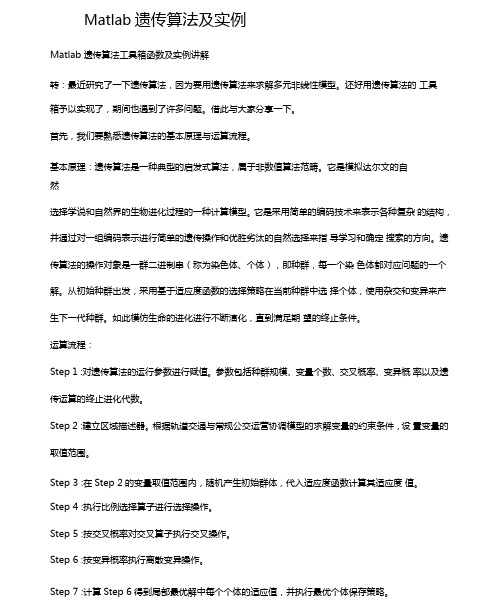
Matlab遗传算法及实例Matlab遗传算法工具箱函数及实例讲解转:最近硏究了一下遗传算法,因为要用遗传算法来求解多元非线性模型。
还好用遗传算法的工具箱予以实现了,期间也遇到了许多问题。
借此与大家分享一下。
首先,我们要熟悉遗传算法的基本原理与运算流程。
基本原理:遗传算法是一种典型的启发式算法,属于非数值算法范畴。
它是模拟达尔文的自然选择学说和自然界的生物进化过程的一种计算模型。
它是采用简单的编码技术来表示各种复杂的结构,并通过对一组编码表示进行简单的遗传操作和优胜劣汰的自然选择来指导学习和确定搜索的方向。
遗传算法的操作对象是一群二进制串(称为染色体、个体),即种群,每一个染色体都对应问题的一个解。
从初始种群出发,采用基于适应度函数的选择策略在当前种群中选择个体,使用杂交和变异来产生下一代种群。
如此模仿生命的进化进行不断演化,直到满足期望的终止条件。
运算流程:Step 1 :对遗传算法的运行参数进行赋值。
参数包括种群规模、变量个数、交叉概率、变异概率以及遗传运算的终止进化代数。
Step 2 :建立区域描述器。
根据轨道交通与常规公交运营协调模型的求解变量的约束条件,设置变量的取值范围。
Step 3 :在Step 2的变量取值范围内,随机产生初始群体,代入适应度函数计算其适应度值。
Step 4 :执行比例选择算子进行选择操作。
Step 5 :按交叉概率对交叉算子执行交叉操作。
Step 6 :按变异概率执行离散变异操作。
Step 7 :计算Step 6得到局部最优解中每个个体的适应值,并执行最优个体保存策略。
Step 8 :判断是否满足遗传运算的终止进化代数,不满足则返回Step 4,满足则输出运算结果其次,运用遗传算法工具箱。
运用基于Matlab的遗传算法工具箱非常方便,遗传算法工具箱里包括了我们需要的各种函数库。
目前,基于Matlab的遗传算法工具箱也很多,比较流行的有英国设菲尔德大学幵发的遗传算法工具箱GATBXGAOT以及Math Works公司推出的GADS实际上,GAD鉞是大家所看到的Matlab中自带的工具箱。
遗传算法及其MATLAB程序
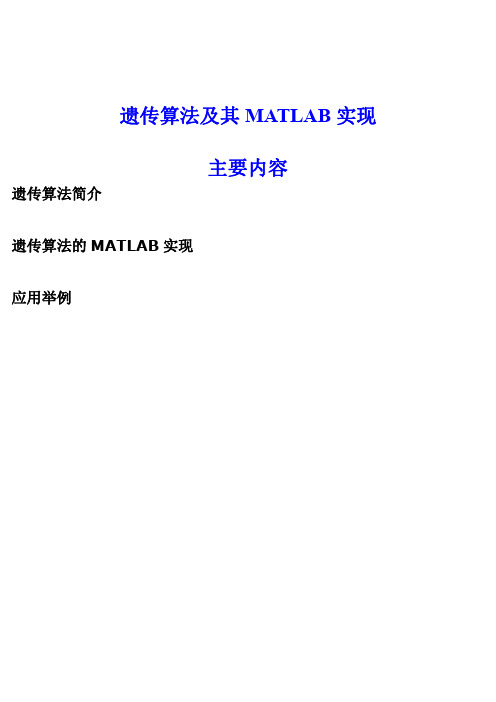
遗传算法及其MATLAB实现主要内容遗传算法简介遗传算法的MATLAB实现应用举例一、遗传算法简介遗传算法(Genetic Algorithm,GA)最先是由美国Mic-hgan大学的John Holland于1975年提出的。
遗传算法是模拟达尔文的遗传选择和自然淘汰的生物进化过程的计算模型。
它的思想源于生物遗传学和适者生存的自然规律,是具有“生存+检测”的迭代过程的搜索算法。
遗传算法以一种群体中的所有个体为对象,并利用随机化技术指导对一个被编码的参数空间进行高效搜索。
其中,选择、交叉和变异构成了遗传算法的遗传操作;参数编码、初始群体的设定、适应度函数的设计、遗传操作设计、控制参数设定等5个要素组成了遗传算法的核心内容。
遗传算法的基本步骤:遗传算法是一种基于生物自然选择与遗传机理的随机搜索算法,与传统搜索算法不同,遗传算法从一组随机产生的称为“种群(Population)”的初始解开始搜索过程。
种群中的每个个体是问题的一个解,称为“染色体(chromos ome)”。
染色体是一串符号,比如一个二进制字符串。
这些染色体在后续迭代中不断进化,称为遗传。
在每一代中用“适值(fitness)”来测量染色体的好坏,生成的下一代染色体称为后代(offspring)。
后代是由前一代染色体通过交叉(crossover)或者变异(mutation)运算形成的。
在新一代形成过程中,根据适度的大小选择部分后代,淘汰部分后代。
从而保持种群大小是常数。
适值高的染色体被选中的概率较高,这样经过若干代之后,算法收敛于最好的染色体,它很可能就是问题的最优解或次优解。
主要步骤如下所示:(1)编码:GA在进行搜索之前先将解空间的解数据表示成遗传空间的基因型串结构数据,这些串结构数据的不同组合便构成了不同的点。
(2)初始群体的生成:随机产生N个初始串结构数据,每个串结构数据称为一个个体,N个个体构成了—个群体。
GA以这N个串结构数据作为初始点开始迭代。
遗传算法MATLAB仿真程序
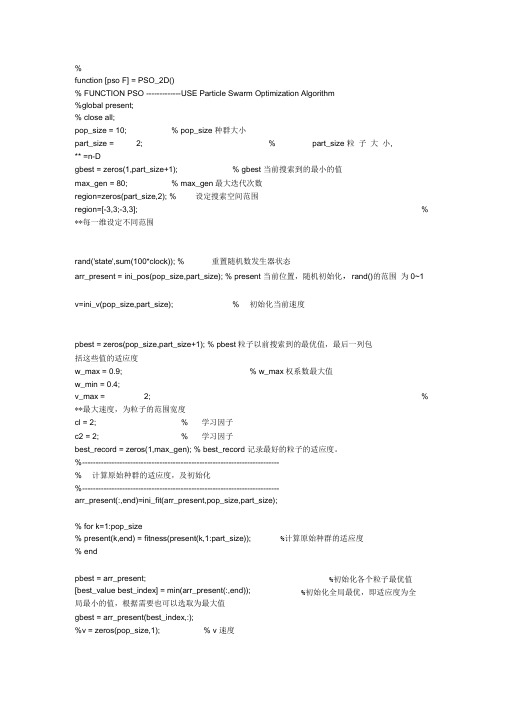
%function [pso F] = PSO_2D()% FUNCTION PSO ------------- U SE Particle Swarm Optimization Algorithm%global present;% close all;pop_size = 10; % pop_size 种群大小part_size = 2; % part_size 粒子大小,** =n-Dgbest = zeros(1,part_size+1); % gbest 当前搜索到的最小的值max_gen = 80; % max_gen最大迭代次数region=zeros(part_size,2); % 设定搜索空间范围region=[-3,3;-3,3]; % **每一维设定不同范围rand('state',sum(100*clock)); % 重置随机数发生器状态arr_present = ini_pos(pop_size,part_size); % present 当前位置,随机初始化,rand()的范围为0~1 v=ini_v(pop_size,part_size); % 初始化当前速度pbest = zeros(pop_size,part_size+1); % pbest粒子以前搜索到的最优值,最后一列包括这些值的适应度w_max = 0.9; % w_max权系数最大值w_min = 0.4;v_max = 2; % **最大速度,为粒子的范围宽度cl = 2; % 学习因子c2 = 2; % 学习因子best_record = zeros(1,max_gen); % best_record 记录最好的粒子的适应度。
% --------------------------------------------------------------------------% 计算原始种群的适应度,及初始化% --------------------------------------------------------------------------arr_present(:,end)=ini_fit(arr_present,pop_size,part_size);% for k=1:pop_size% present(k,end) = fitness(present(k,1:part_size)); %计算原始种群的适应度% endpbest = arr_present;[best_value best_index] = min(arr_present(:,end)); 局最小的值,根据需要也可以选取为最大值gbest = arr_present(best_index,:);%v = zeros(pop_size,1); % v 速度%初始化各个粒子最优值%初始化全局最优,即适应度为全% --------------------------------------------------------------------------% 迭代% ————————————————————————% global m;% m = moviein(1000); % 生成帧矩阵x=[-3:0.01:3];y=[-3:0.01:3];z=@(x,y) 3*(1-x).A2.*exp(-(x.A2) - (y+1).A2) ...-10*(x/ 5 - x.A3 - y,5).*exp(-x.A2-y.A2) ...-1/3*exp(-(x+1),2 - y.A2);for i=1:max_gengrid on;plot3(x,y,z);% subplot(121),ezmesh(z),hold on,grid on,plot3(arr_present(:,1),arr_present(:,2),arr_present(:,3),'*'),hold off;% subplot(122),ezmesh(z),view([145,90]),hold on,gridon,plot3(arr_present(:,1),arr_present(:,2),arr_present(:,3),'*'),hold off;ezmesh(z),hold on,grid on,plot3(arr_present(:,1),arr_present(:,2),arr_present(:,3),'*'),hold off;drawnowF(i)=getframe;% ezmesh(z)% % view([-37,90])% hold on;% grid on;% % plot(-0.0898,0.7126,'ro');%plot3(arr_present(:,1),arr_present(:,2),arr_present(:,3),'*');%改为三维% axis([-2*pi,2*pi,-pi,pi,-50,10]);% hold off;pause(0.01);% m(:,i) = getframe; %添加图形w = w_max-(w_max-w_min)*i/max_gen;% fprintf('# %i 代开始!\n',i);% 确定是否对打散已经收敛的粒子群---------------------------------------reset = 0; % reset = 1时设置为粒子群过分收敛时将其打散,如果= 1则不打散if reset==1bit = 1;for k=1:part_sizebit = bit&(range(arr_present(:,k))<0.1);endif bit==1 % bit=1时对粒子位置及速度进行随机重置arr_present = ini_pos(pop_size,part_size); % present 当前位置,随机初始化 v = ini_v(pop_size,part_size); %速度初始化for k=1:pop_size%重新计算适应度arr_present(k,end) = fitness(arr_present(k,1:part_size));endwarning('粒子过分集中!重新初始化 ... '); %给出信息display(i); end endfor j=1:pop_sizev(j,:) = w.*v(j,:)+c1.*rand.*(pbest(j,1:part_size)-arr_present(j,1:part_size))...+c2.*rand.*(gbest(1:part_size)-arr_present(j,1:part_size)); % 粒子速度更新(a)% 判断v 的大小,限制v 的绝对值小于5 c=find(abs(v)>6); %**最大速度设置,粒子的范围宽度 v(c) = sign(v(c))*6; %如果速度大于 3.14贝U,速度为3.14arr_present(j,1:part_size)=arr_present(j,1:part_size)+v(j,1:part_size);% 粒子位置更新(b)arr_present(j,end) = fitness(arr_present(j,1:part_size));if (arr_present(j,end)>pbest(j,end))&(Region_in(arr_present(j,:),region))% 根据条件更新pbest ,如果是最小的值为小于号,相反则为大于号 pbest(j,:) = arr_present(j,:);end end[best max(arr_present(:,end)); min ,相反则为 maxif best>gbest(end)&(Region_in(arr_present(best_index,:),region)) %best_index] %如果是最小的值为如果当前最好的结果比以前的好,则更新最优值gbest,如果是最小的值为小于号,相反则为大于号gbest = arr_present(best_index,:);endbest_record(i) = gbest(end);endpso = gbest;display(gbest);% figure;% plot(best_record);% movie2avi(F,'pso_2D1.avi','compression','MSVC');%***************************************************************************% 计算适应度%***************************************************************************function fit = fitness(present)fit=3*(1-present(1)).A2.*exp(-(present(1).A2) - (present(2)+1).A2) ... %** 需要求极值的函数,本例即peaks函数-10*(present(1)/ 5 - present(1),3 - present(2).A5).*exp(-present(1),2-present(2).A2) ...-1/3*exp(-(present(1)+1)A2 - present(2)A2);function ini_present=ini_pos(pop_size,part_size)ini_present = 3*rand(pop_size,part_size+1); %初始化当前粒子位置,使其随机的分布在工作空间%** 6即为自变量范围functionini_velocity=ini_v(pop_size,part_size)ini_velocity =32*(rand(pop_size,part_size)); %初始化当前粒子速度,使其随机的分布在速度范围内function flag=Region_in(pos_present,region)[m n]=size(pos_present);flag=1;for j=1:n-1flag=flag&(pos_present(1:j)>=region(j,1))&(pos_present(1:j)<=region(j,2)); endfunction arr_fitness=ini_fit(pos_present,pop_size,part_size)for k=1:pop_sizearr_fitness(k,1) = fitness(pos_present(k,1:part_size)); %计算原始种群的适应度end。
2020年遗传算法matlab程序实例精编版
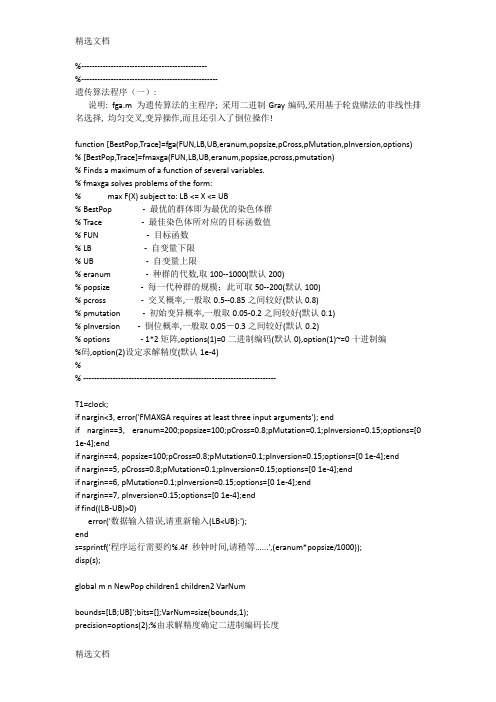
%-----------------------------------------------%---------------------------------------------------遗传算法程序(一):说明: fga.m 为遗传算法的主程序; 采用二进制Gray编码,采用基于轮盘赌法的非线性排名选择, 均匀交叉,变异操作,而且还引入了倒位操作!function [BestPop,Trace]=fga(FUN,LB,UB,eranum,popsize,pCross,pMutation,pInversion,options) % [BestPop,Trace]=fmaxga(FUN,LB,UB,eranum,popsize,pcross,pmutation)% Finds a maximum of a function of several variables.% fmaxga solves problems of the form:% max F(X) subject to: LB <= X <= UB% BestPop - 最优的群体即为最优的染色体群% Trace - 最佳染色体所对应的目标函数值% FUN - 目标函数% LB - 自变量下限% UB - 自变量上限% eranum - 种群的代数,取100--1000(默认200)% popsize - 每一代种群的规模;此可取50--200(默认100)% pcross - 交叉概率,一般取0.5--0.85之间较好(默认0.8)% pmutation - 初始变异概率,一般取0.05-0.2之间较好(默认0.1)% pInversion - 倒位概率,一般取0.05-0.3之间较好(默认0.2)% options - 1*2矩阵,options(1)=0二进制编码(默认0),option(1)~=0十进制编%码,option(2)设定求解精度(默认1e-4)%% ------------------------------------------------------------------------T1=clock;if nargin<3, error('FMAXGA requires at least three input arguments'); endif nargin==3, eranum=200;popsize=100;pCross=0.8;pMutation=0.1;pInversion=0.15;options=[0 1e-4];endif nargin==4, popsize=100;pCross=0.8;pMutation=0.1;pInversion=0.15;options=[0 1e-4];endif nargin==5, pCross=0.8;pMutation=0.1;pInversion=0.15;options=[0 1e-4];endif nargin==6, pMutation=0.1;pInversion=0.15;options=[0 1e-4];endif nargin==7, pInversion=0.15;options=[0 1e-4];endif find((LB-UB)>0)error('数据输入错误,请重新输入(LB<UB):');ends=sprintf('程序运行需要约%.4f 秒钟时间,请稍等......',(eranum*popsize/1000));disp(s);global m n NewPop children1 children2 VarNumbounds=[LB;UB]';bits=[];VarNum=size(bounds,1);precision=options(2);%由求解精度确定二进制编码长度bits=ceil(log2((bounds(:,2)-bounds(:,1))' ./ precision));%由设定精度划分区间[Pop]=InitPopGray(popsize,bits);%初始化种群[m,n]=size(Pop);NewPop=zeros(m,n);children1=zeros(1,n);children2=zeros(1,n);pm0=pMutation;BestPop=zeros(eranum,n);%分配初始解空间BestPop,TraceTrace=zeros(eranum,length(bits)+1);i=1;while i<=eranumfor j=1:mvalue(j)=feval(FUN(1,:),(b2f(Pop(j,:),bounds,bits)));%计算适应度end[MaxValue,Index]=max(value);BestPop(i,:)=Pop(Index,:);Trace(i,1)=MaxValue;Trace(i,(2:length(bits)+1))=b2f(BestPop(i,:),bounds,bits);[selectpop]=NonlinearRankSelect(FUN,Pop,bounds,bits);%非线性排名选择[CrossOverPop]=CrossOver(selectpop,pCross,round(unidrnd(eranum-i)/eranum));%采用多点交叉和均匀交叉,且逐步增大均匀交叉的概率%round(unidrnd(eranum-i)/eranum)[MutationPop]=Mutation(CrossOverPop,pMutation,VarNum);%变异[InversionPop]=Inversion(MutationPop,pInversion);%倒位Pop=InversionPop;%更新pMutation=pm0+(i^4)*(pCross/3-pm0)/(eranum^4);%随着种群向前进化,逐步增大变异率至1/2交叉率p(i)=pMutation;i=i+1;endt=1:eranum;plot(t,Trace(:,1)');title('函数优化的遗传算法');xlabel('进化世代数(eranum)');ylabel('每一代最优适应度(maxfitness)');[MaxFval,I]=max(Trace(:,1));X=Trace(I,(2:length(bits)+1));hold on; plot(I,MaxFval,'*');text(I+5,MaxFval,['FMAX=' num2str(MaxFval)]);str1=sprintf ('进化到%d 代,自变量为%s 时,得本次求解的最优值%f\n对应染色体是:%s',I,num2str(X),MaxFval,num2str(BestPop(I,:)));disp(str1);%figure(2);plot(t,p);%绘制变异值增大过程T2=clock;elapsed_time=T2-T1;if elapsed_time(6)<0elapsed_time(6)=elapsed_time(6)+60; elapsed_time(5)=elapsed_time(5)-1;endif elapsed_time(5)<0elapsed_time(5)=elapsed_time(5)+60;elapsed_time(4)=elapsed_time(4)-1;end %像这种程序当然不考虑运行上小时啦str2=sprintf('程序运行耗时%d 小时%d 分钟%.4f 秒',elapsed_time(4),elapsed_time(5),elapsed_time(6));disp(str2);%初始化种群%采用二进制Gray编码,其目的是为了克服二进制编码的Hamming悬崖缺点function [initpop]=InitPopGray(popsize,bits)len=sum(bits);initpop=zeros(popsize,len);%The whole zero encoding individualfor i=2:popsize-1pop=round(rand(1,len));pop=mod(([0 pop]+[pop 0]),2);%i=1时,b(1)=a(1);i>1时,b(i)=mod(a(i-1)+a(i),2)%其中原二进制串:a(1)a(2)...a(n),Gray串:b(1)b(2)...b(n)initpop(i,:)=pop(1:end-1);endinitpop(popsize,:)=ones(1,len);%The whole one encoding individual%%%%% %%%%%%%%%%%%%%%%%%%%%%%%%%%%%%%%%%%%%%%%%%%%%%%%%%%%%%% %%%%%%%%%%%%%%%%%%%%%%%%%%%%%%%%%%%%%%%%%%%%%%%%%%%%%%% %%解码function [fval] = b2f(bval,bounds,bits)% fval - 表征各变量的十进制数% bval - 表征各变量的二进制编码串% bounds - 各变量的取值范围% bits - 各变量的二进制编码长度scale=(bounds(:,2)-bounds(:,1))'./(2.^bits-1); %The range of the variablesnumV=size(bounds,1);cs=[0 cumsum(bits)];for i=1:numVa=bval((cs(i)+1):cs(i+1));fval(i)=sum(2.^(size(a,2)-1:-1:0).*a)*scale(i)+bounds(i,1);end%选择操作%采用基于轮盘赌法的非线性排名选择%各个体成员按适应值从大到小分配选择概率:%P(i)=(q/1-(1-q)^n)*(1-q)^i, 其中P(0)>P(1)>...>P(n), sum(P(i))=1function [selectpop]=NonlinearRankSelect(FUN,pop,bounds,bits)global m nselectpop=zeros(m,n);fit=zeros(m,1);for i=1:mfit(i)=feval(FUN(1,:),(b2f(pop(i,:),bounds,bits)));%以函数值为适应值做排名依据endselectprob=fit/sum(fit);%计算各个体相对适应度(0,1)q=max(selectprob);%选择最优的概率x=zeros(m,2);x(:,1)=[m:-1:1]';[y x(:,2)]=sort(selectprob);r=q/(1-(1-q)^m);%标准分布基值newfit(x(:,2))=r*(1-q).^(x(:,1)-1);%生成选择概率newfit=cumsum(newfit);%计算各选择概率之和rNums=sort(rand(m,1));fitIn=1;newIn=1;while newIn<=mif rNums(newIn)<newfit(fitIn)selectpop(newIn,:)=pop(fitIn,:);newIn=newIn+1;elsefitIn=fitIn+1;endend%交叉操作function [NewPop]=CrossOver(OldPop,pCross,opts)%OldPop为父代种群,pcross为交叉概率global m n NewPopr=rand(1,m);y1=find(r<pCross);y2=find(r>=pCross);len=length(y1);if len>2&mod(len,2)==1%如果用来进行交叉的染色体的条数为奇数,将其调整为偶数y2(length(y2)+1)=y1(len);y1(len)=[];endif length(y1)>=2for i=0:2:length(y1)-2if opts==0[NewPop(y1(i+1),:),NewPop(y1(i+2),:)]=EqualCrossOver(OldPop(y1(i+1),:),OldPop(y1(i+2),:));else[NewPop(y1(i+1),:),NewPop(y1(i+2),:)]=MultiPointCross(OldPop(y1(i+1),:),OldPop(y1(i+2),:));endendendNewPop(y2,:)=OldPop(y2,:);%采用均匀交叉function [children1,children2]=EqualCrossOver(parent1,parent2)global n children1 children2hidecode=round(rand(1,n));%随机生成掩码crossposition=find(hidecode==1);holdposition=find(hidecode==0);children1(crossposition)=parent1(crossposition);%掩码为1,父1为子1提供基因children1(holdposition)=parent2(holdposition);%掩码为0,父2为子1提供基因children2(crossposition)=parent2(crossposition);%掩码为1,父2为子2提供基因children2(holdposition)=parent1(holdposition);%掩码为0,父1为子2提供基因%采用多点交叉,交叉点数由变量数决定function [Children1,Children2]=MultiPointCross(Parent1,Parent2)global n Children1 Children2 VarNumChildren1=Parent1;Children2=Parent2;Points=sort(unidrnd(n,1,2*VarNum));for i=1:VarNumChildren1(Points(2*i-1):Points(2*i))=Parent2(Points(2*i-1):Points(2*i));Children2(Points(2*i-1):Points(2*i))=Parent1(Points(2*i-1):Points(2*i));end%变异操作function [NewPop]=Mutation(OldPop,pMutation,VarNum)global m n NewPopr=rand(1,m);position=find(r<=pMutation);len=length(position);if len>=1for i=1:lenk=unidrnd(n,1,VarNum); %设置变异点数,一般设置1点for j=1:length(k)if OldPop(position(i),k(j))==1OldPop(position(i),k(j))=0;elseOldPop(position(i),k(j))=1;endendendendNewPop=OldPop;%%%%%%%%%%%%%%%%%%%%%%%%%%%%%%%%%%%%%%%%%%%%%%%%%%%%%%% %%%%%%%%%%%%%%%%%%%%%%%%%%%%%%%%%%%%%%%%%%%%%%%%%%%%%%% %%%%%%%%%%%倒位操作function [NewPop]=Inversion(OldPop,pInversion)global m n NewPopNewPop=OldPop;r=rand(1,m);PopIn=find(r<=pInversion);len=length(PopIn);if len>=1for i=1:lend=sort(unidrnd(n,1,2));if d(1)~=1&d(2)~=nNewPop(PopIn(i),1:d(1)-1)=OldPop(PopIn(i),1:d(1)-1);NewPop(PopIn(i),d(1):d(2))=OldPop(PopIn(i),d(2):-1:d(1));NewPop(PopIn(i),d(2)+1:n)=OldPop(PopIn(i),d(2)+1:n);endendend遗传算法程序(二):function youhuafunD=code;N=50; % Tunablemaxgen=50; % Tunablecrossrate=0.5; %Tunablemuterate=0.08; %Tunablegeneration=1;num = length(D);fatherrand=randint(num,N,3);score = zeros(maxgen,N);while generation<=maxgenind=randperm(N-2)+2; % 随机配对交叉A=fatherrand(:,ind(1:(N-2)/2));B=fatherrand(:,ind((N-2)/2+1:end));% 多点交叉rnd=rand(num,(N-2)/2);ind=rnd tmp=A(ind);A(ind)=B(ind);B(ind)=tmp;% % 两点交叉% for kk=1:(N-2)/2% rndtmp=randint(1,1,num)+1;% tmp=A(1:rndtmp,kk);% A(1:rndtmp,kk)=B(1:rndtmp,kk);% B(1:rndtmp,kk)=tmp;% endfatherrand=[fatherrand(:,1:2),A,B];% 变异rnd=rand(num,N);ind=rnd [m,n]=size(ind);tmp=randint(m,n,2)+1;tmp(:,1:2)=0;fatherrand=tmp+fatherrand;fatherrand=mod(fatherrand,3);% fatherrand(ind)=tmp;%评价、选择scoreN=scorefun(fatherrand,D);% 求得N个个体的评价函数score(generation,:)=scoreN;[scoreSort,scoreind]=sort(scoreN);sumscore=cumsum(scoreSort);sumscore=sumscore./sumscore(end);childind(1:2)=scoreind(end-1:end);for k=3:Ntmprnd=rand;tmpind=tmprnd difind=[0,diff(tmpind)];if ~any(difind)difind(1)=1;endchildind(k)=scoreind(logical(difind));endfatherrand=fatherrand(:,childind);generation=generation+1;end% scoremaxV=max(score,[],2);minV=11*300-maxV;plot(minV,'*');title('各代的目标函数值');F4=D(:,4);FF4=F4-fatherrand(:,1);FF4=max(FF4,1);D(:,5)=FF4;save DData Dfunction D=codeload youhua.mat% properties F2 and F3F1=A(:,1);F2=A(:,2);F3=A(:,3);if (max(F2)>1450)||(min(F2)<=900)error('DATA property F2 exceed it''s range (900,1450]')end% get group property F1 of data, according to F2 valueF4=zeros(size(F1));for ite=11:-1:1index=find(F2<=900+ite*50);F4(index)=ite;endD=[F1,F2,F3,F4];function ScoreN=scorefun(fatherrand,D)F3=D(:,3);F4=D(:,4);N=size(fatherrand,2);FF4=F4*ones(1,N);FF4rnd=FF4-fatherrand;FF4rnd=max(FF4rnd,1);ScoreN=ones(1,N)*300*11;% 这里有待优化for k=1:NFF4k=FF4rnd(:,k);for ite=1:11F0index=find(FF4k==ite);if ~isempty(F0index)tmpMat=F3(F0index);tmpSco=sum(tmpMat);ScoreBin(ite)=mod(tmpSco,300);endendScorek(k)=sum(ScoreBin);endScoreN=ScoreN-Scorek;%%%%%%%%%%%%%%%%%%%%%%%%%%%%%%%%%%%%%%%%%%%%%%%%%%%%%%% %%%%%%%%%%%%%%%%%%%%%%%%%%%%%%%%%%%%%%%%%%%%%%%%%%%%%%% %%%%%%%%%%遗传算法程序(三):%IAGAfunction best=gaclearMAX_gen=200; %最大迭代步数best.max_f=0; %当前最大的适应度STOP_f=14.5; %停止循环的适应度RANGE=[0 255]; %初始取值范围[0 255]SPEEDUP_INTER=5; %进入加速迭代的间隔advance_k=0; %优化的次数popus=init; %初始化for gen=1:MAX_genfitness=fit(popus,RANGE); %求适应度f=fitness.f;picked=choose(popus,fitness); %选择popus=intercross(popus,picked); %杂交popus=aberrance(popus,picked); %变异if max(f)>best.max_fadvance_k=advance_k+1;x_better(advance_k)=fitness.x;best.max_f=max(f);best.popus=popus;best.x=fitness.x;endif mod(advance_k,SPEEDUP_INTER)==0RANGE=minmax(x_better);RANGEadvance=0;endendreturn;function popus=init%初始化M=50;%种群个体数目N=30;%编码长度popus=round(rand(M,N));return;function fitness=fit(popus,RANGE)%求适应度[M,N]=size(popus);fitness=zeros(M,1);%适应度f=zeros(M,1);%函数值A=RANGE(1);B=RANGE(2);%初始取值范围[0 255]for m=1:Mx=0;for n=1:Nx=x+popus(m,n)*(2^(n-1));endx=x*((B-A)/(2^N))+A;for k=1:5f(m,1)=f(m,1)-(k*sin((k+1)*x+k));endendf_std=(f-min(f))./(max(f)-min(f));%函数值标准化fitness.f=f;fitness.f_std=f_std;fitness.x=x;return;function picked=choose(popus,fitness)%选择f=fitness.f;f_std=fitness.f_std;[M,N]=size(popus);choose_N=3; %选择choose_N对双亲picked=zeros(choose_N,2); %记录选择好的双亲p=zeros(M,1); %选择概率d_order=zeros(M,1);%把父代个体按适应度从大到小排序f_t=sort(f,'descend');%将适应度按降序排列for k=1:Mx=find(f==f_t(k));%降序排列的个体序号d_order(k)=x(1);endfor m=1:Mpopus_t(m,:)=popus(d_order(m),:);endpopus=popus_t;f=f_t;p=f_std./sum(f_std); %选择概率c_p=cumsum(p)'; %累积概率for cn=1:choose_Npicked(cn,1)=roulette(c_p); %轮盘赌picked(cn,2)=roulette(c_p); %轮盘赌popus=intercross(popus,picked(cn,:));%杂交endpopus=aberrance(popus,picked);%变异return;function popus=intercross(popus,picked) %杂交[M_p,N_p]=size(picked);[M,N]=size(popus);for cn=1:M_pp(1)=ceil(rand*N);%生成杂交位置p(2)=ceil(rand*N);p=sort(p);t=popus(picked(cn,1),p(1):p(2));popus(picked(cn,1),p(1):p(2))=popus(picked(cn,2),p(1):p(2));popus(picked(cn,2),p(1):p(2))=t;endreturn;function popus=aberrance(popus,picked) %变异P_a=0.05;%变异概率[M,N]=size(popus);[M_p,N_p]=size(picked);U=rand(1,2);for kp=1:M_pif U(2)>=P_a %如果大于变异概率,就不变异continue;endif U(1)>=0.5a=picked(kp,1);elsea=picked(kp,2);endp(1)=ceil(rand*N);%生成变异位置p(2)=ceil(rand*N);if popus(a,p(1))==1%0 1变换popus(a,p(1))=0;elsepopus(a,p(1))=1;endif popus(a,p(2))==1popus(a,p(2))=0;elsepopus(a,p(2))=1;endendreturn;function picked=roulette(c_p) %轮盘赌[M,N]=size(c_p);M=max([M N]);U=rand;if U<c_p(1)picked=1;return;endfor m=1:(M-1)if U>c_p(m) & U<c_p(m+1)picked=m+1;break;endend全方位的两点杂交、两点变异的改进的加速遗传算法(IAGA)%%%%%%%%%%%%%%%%%%%%%%%%%%%%%%%%%%%%%%%%%%%%%%%%%%%%%%% %%%%%%%%%%%%%%%%%%%%%%%%%%%%%%%%%%%%%%%%%%%%%%%%%%%%%%% %%%%%%%%%%%%%%%%%%%%%%%%%%%%%%%%%%%%%%%%%%%%%%%%%%%%%%%%%%%%%%%%% %%%%%%%%%%%%%%%%%%%%%%%%%%%%%%%%%%%%%%%%%%%%%%%%%%%%%%% %%%%%%%%%%%%%%%%%%%%%%%%%%%%%%%%%%%%%%%%%%%%%%%%%%%%%%%%%%%%%%%%% %%%%%%%%%%%%%%%%%%%%%%%%%%%%%%%%%%%%%%%%%%%%%%%%%%%%%%% %%%%%%%%%% %%%%%%%%%%%%%%%%%%%%%%%%%%%%%%%%%%%%%%%%%%%%%%%%%%%%%%% %%%%%%%%%%%%%%%%%%%%%%%%%%%%%%%%%%%%%%%%%%%%%%%%%%%%%%% %%%%%%%%%%。
遗传算法应用实例及matlab程序

遗传算法应用实例及matlab程序遗传算法是一种模拟自然进化过程的优化算法,在多个领域都有广泛的应用。
下面将以一个经典的实例,车间调度问题,来说明遗传算法在实际问题中的应用,并给出一个基于MATLAB的实现。
车间调度问题是一个经典的组合优化问题,它是指在给定一系列任务和一台机器的情况下,如何安排任务的执行顺序,以便最小化任务的完成时间或最大化任务的完成效率。
这个问题通常是NP困难问题,因此传统的优化算法往往难以找到全局最优解。
遗传算法能够解决车间调度问题,其基本思想是通过模拟生物进化的过程,不断演化和改进任务的调度顺序,以找到最优解。
具体步骤如下:1. 初始种群的生成:生成一批初始调度方案,每个方案都表示为一个染色体,一般采用随机生成的方式。
2. 个体适应度的计算:根据染色体中任务的执行顺序,计算每个调度方案的适应度值,一般使用任务完成时间作为适应度度量。
3. 选择操作:根据个体的适应度,采用选择策略选择一部分优秀个体作为父代。
4. 交叉操作:对选中的个体进行交叉操作,生成新的子代个体。
5. 变异操作:对子代个体进行变异操作,引入随机性,增加搜索空间的广度。
6. 替换操作:用新的个体替换原来的个体,形成新一代的种群。
7. 迭代过程:重复执行选择、交叉、变异和替换操作,直到达到预定的终止条件。
下面给出基于MATLAB的实现示例:matlabfunction [best_solution, best_fitness] =genetic_algorithm(num_generations, population_size) % 初始化种群population = generate_population(population_size);for generation = 1:num_generations% 计算适应度fitness = calculate_fitness(population);% 选择操作selected_population = selection(population, fitness);% 交叉操作crossed_population = crossover(selected_population);% 变异操作mutated_population = mutation(crossed_population);% 替换操作population = replace(population, selected_population, mutated_population);end% 找到最优解[~, index] = max(fitness);best_solution = population(index,:);best_fitness = fitness(index);endfunction population = generate_population(population_size) % 根据问题的具体要求,生成初始种群population = randi([1, num_tasks], [population_size, num_tasks]); endfunction fitness = calculate_fitness(population)% 根据任务执行顺序,计算每个调度方案的适应度% 这里以任务完成时间作为适应度度量fitness = zeros(size(population, 1), 1);for i = 1:size(population, 1)solution = population(i,:);% 计算任务完成时间completion_time = calculate_completion_time(solution);% 适应度为任务完成时间的倒数fitness(i) = 1 / completion_time;endendfunction selected_population = selection(population, fitness) % 根据适应度值选择父代个体% 这里采用轮盘赌选择策略selected_population = zeros(size(population));for i = 1:size(population, 1)% 计算选择概率prob = fitness / sum(fitness);% 轮盘赌选择selected_population(i,:) = population(find(rand <= cumsum(prob), 1),:);endendfunction crossed_population = crossover(selected_population) % 对选中的个体进行交叉操作% 这里采用单点交叉crossed_population = zeros(size(selected_population));for i = 1:size(selected_population, 1) / 2parent1 = selected_population(2*i-1,:);parent2 = selected_population(2*i,:);% 随机选择交叉点crossover_point = randi([1, size(parent1,2)]);% 交叉操作crossed_population(2*i-1,:) = [parent1(1:crossover_point), parent2(crossover_point+1:end)];crossed_population(2*i,:) = [parent2(1:crossover_point), parent1(crossover_point+1:end)];endendfunction mutated_population = mutation(crossed_population) % 对子代个体进行变异操作% 这里采用单点变异mutated_population = crossed_population;for i = 1:size(mutated_population, 1)individual = mutated_population(i,:);% 随机选择变异点mutation_point = randi([1, size(individual,2)]);% 变异操作mutated_population(i,mutation_point) = randi([1, num_tasks]);endendfunction new_population = replace(population, selected_population, mutated_population)% 根据选择、交叉和变异得到的个体替换原来的个体new_population = mutated_population;for i = 1:size(population, 1)if ismember(population(i,:), selected_population, 'rows')% 保留选择得到的个体continue;else% 随机选择一个父代个体进行替换index = randi([1, size(selected_population,1)]);new_population(i,:) = selected_population(index,:);endendend该示例代码实现了车间调度问题的遗传算法求解过程,具体实现了种群的初始化、适应度计算、选择、交叉、变异和替换等操作。
遗传算法仿真实验
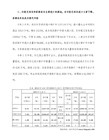
遗传算法仿真实验遗传算法是建立在自然选择和自然遗传学机理基础上的迭代自适应概率性搜索,一般由初始化、选择、交叉、突然变异四部分组成;它的一个重要应用就是数值优化。
一、实验目的:1、了解用于数值优化的遗传算法的原理2、用 matlab 语言编程实现遗传算法二.实验任务:计算以下一元函数的最大值并按上例所示画出适应度函数图:1、f(x)=x^2+4x+6 ,x∈[1,5] 要求解精确到 6 位小数2、f(x)=xsin(10πx)+2,x∈[-1,2] 要求解精确到 6 位小数三.实验过程1)f(x)=x^2+4x+6 ,x∈[1,5]接下来用 matlab 语言编程实现该遗传算法:function [Max_Value,x]=one(umin,umax)%运行参数Size=80;G=100;CodeL=22;E=round(rand(Size,CodeL));%产生 80 个离散点的二进制编码解码%主程序for k=1:1:Gtime(k)=k;for s=1:1:Sizem=E(s,:);y=0;for i=1:1:CodeLy=y+m(i)*2^(i-1);endx=(umax-umin)*y/4194303+umin;F(s)= myfunction_one (x); %调用 my function _ one 函数产生每个离散点的适应度endJi=1./F;%注意这里是点乘BestJ(k)=min(Ji);%每步最优的目标函数fi=F;%定义适应度函数[Oderfi,Indexfi]=sort(fi);%将 80 个个体的适应度从小到大排序Bestfi=Oderfi(Size);BestS=E(Indexfi(Size),:);bfi(k)=Bestfi;%每步最优的适应度fi_sum=sum(fi);fi_Size=(Oderfi/fi_sum)*Size;fi_S=floor(fi_Size);kk=1;for i=1:1:Size %选择并复制个体for j=1:1:fi_S(i)TempE(kk,:)=E(Indexfi(i),:);kk=kk+1;endendpc=0.25;n=ceil(22*rand);%随机产生交叉的位for i=1:2:(Size-1)temp=rand;if pc>temp %满足交叉条件for j=n:1:22TempE(i,j)=E(i+1,j);TempE(i+1,j)=E(i,j);endendendTempE(Size,:)=BestS;E=TempE;pm=0.01for i=1:1:Sizefor j=1:1:CodeLtemp=rand;if pm>tempif TempE(i,j)==0TempE(i,j)=1;elseTempE(i,j)=0;endendendendTempE(Size,:)=BestS;E=TempE;end%满足变异条件Max_Value=Bestfi %输出最大值BestS %输出最大值对应的离散点的二进制编码x %输出取最大值是 x 的值figure(1); %画出迭代 100 步的适应度变化图和目标函数图plot(time,BestJ);xlabel('Times');ylabel('Best J');figure(2);plot(time,bfi);xlabel('times');ylabel('Best F');%以下是计算适应度函数的程序:function t=myfunction_one(x)t=x^2+4x+6;将程序保存为.m文件,在命令窗口输入:one(1,5)回车,运行程序,得到结果如下:Max_V alue =51.0000x =5.0000即函数在x=5.0000,处得到最大值51.0000得到适应度函数为为:2)f(x)=xsin(10πx)+2 ,接下来用 matlab 语言编程实现该遗传算法:function [Max_Value,x]=one(umin,umax)%运行参数Size=80;G=100;CodeL=22;E=round(rand(Size,CodeL));%产生 80 个离散点的二进制编码解码%主程序for k=1:1:Gtime(k)=k;for s=1:1:Sizem=E(s,:);y=0;for i=1:1:CodeLy=y+m(i)*2^(i-1);endx=(umax-umin)*y/4194303+umin;F(s)= myfunction_one (x); %调用 my function _ one 函数产生每个离散点的适应度endJi=1./F;%注意这里是点乘BestJ(k)=min(Ji);%每步最优的目标函数fi=F;%定义适应度函数[Oderfi,Indexfi]=sort(fi);%将 80 个个体的适应度从小到大排序Bestfi=Oderfi(Size);BestS=E(Indexfi(Size),:);bfi(k)=Bestfi;%每步最优的适应度fi_sum=sum(fi);fi_Size=(Oderfi/fi_sum)*Size;fi_S=floor(fi_Size);kk=1;for i=1:1:Size %选择并复制个体for j=1:1:fi_S(i)TempE(kk,:)=E(Indexfi(i),:);kk=kk+1;endendpc=0.25;n=ceil(22*rand);%随机产生交叉的位for i=1:2:(Size-1)temp=rand;if pc>temp %满足交叉条件for j=n:1:22TempE(i,j)=E(i+1,j);TempE(i+1,j)=E(i,j);endendendTempE(Size,:)=BestS;E=TempE;pm=0.01for i=1:1:Sizefor j=1:1:CodeLtemp=rand;if pm>tempif TempE(i,j)==0TempE(i,j)=1;elseTempE(i,j)=0;endendendendTempE(Size,:)=BestS;E=TempE;end%满足变异条件Max_Value=Bestfi %输出最大值BestS %输出最大值对应的离散点的二进制编码x %输出取最大值是 x 的值figure(1); %画出迭代 100 步的适应度变化图和目标函数图plot(time,BestJ);xlabel('Times');ylabel('Best J');figure(2);plot(time,bfi);xlabel('times');ylabel('Best F');%以下是计算适应度函数的程序:function t=myfunction_one(x)t=x*sin(10*pi*x)+2;将程序保存为.m文件,在命令窗口输入:one(-1,2)回车,运行程序,得到结果如下:Max_V alue =3.8503x =1.8506即函数在x= 2.0000 处得到最大值18.0000得到适应度函数为:。
遗传算法matlab程序代码
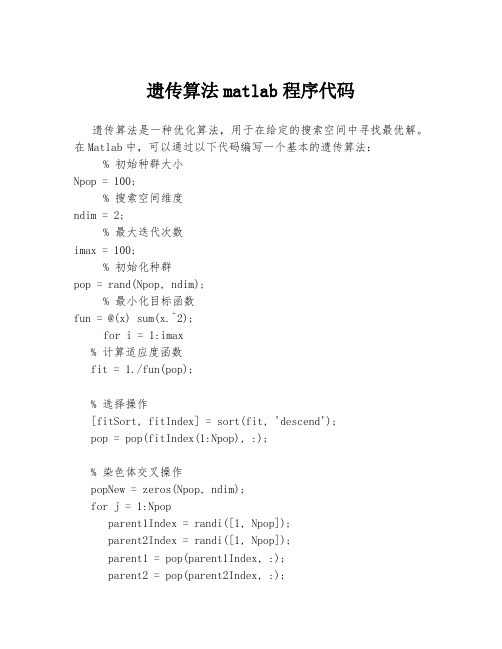
遗传算法matlab程序代码遗传算法是一种优化算法,用于在给定的搜索空间中寻找最优解。
在Matlab中,可以通过以下代码编写一个基本的遗传算法:% 初始种群大小Npop = 100;% 搜索空间维度ndim = 2;% 最大迭代次数imax = 100;% 初始化种群pop = rand(Npop, ndim);% 最小化目标函数fun = @(x) sum(x.^2);for i = 1:imax% 计算适应度函数fit = 1./fun(pop);% 选择操作[fitSort, fitIndex] = sort(fit, 'descend');pop = pop(fitIndex(1:Npop), :);% 染色体交叉操作popNew = zeros(Npop, ndim);for j = 1:Npopparent1Index = randi([1, Npop]);parent2Index = randi([1, Npop]);parent1 = pop(parent1Index, :);parent2 = pop(parent2Index, :);crossIndex = randi([1, ndim-1]);popNew(j,:) = [parent1(1:crossIndex),parent2(crossIndex+1:end)];end% 染色体突变操作for j = 1:NpopmutIndex = randi([1, ndim]);mutScale = randn();popNew(j, mutIndex) = popNew(j, mutIndex) + mutScale;end% 更新种群pop = [pop; popNew];end% 返回最优解[resultFit, resultIndex] = max(fit);result = pop(resultIndex, :);以上代码实现了一个简单的遗传算法,用于最小化目标函数x1^2 + x2^2。
遗传算法的MATLAB实现实例
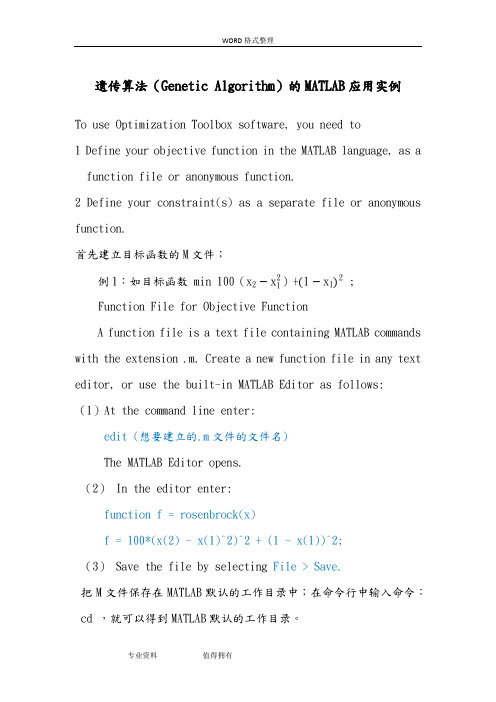
遗传算法(Genetic Algorithm)的MATLAB应用实例To use Optimization Toolbox software, you need to1 Define your objective function in the MATLAB language, as a function file or anonymous function.2 Define your constraint(s) as a separate file or anonymous function.首先建立目标函数的M文件;例1:如目标函数 min 100( )+ ;Function File for Objective FunctionA function file is a text file containing MATLAB commands with the extension .m. Create a new function file in any text editor, or use the built-in MATLAB Editor as follows:(1)At the command line enter:edit (想要建立的.m文件的文件名)The MATLAB Editor opens.(2) In the editor enter:function f = rosenbrock(x)f = 100*(x(2) - x(1)^2)^2 + (1 - x(1))^2;(3) Save the file by selecting File > Save.把M文件保存在MATLAB默认的工作目录中;在命令行中输入命令:cd ,就可以得到MATLAB默认的工作目录。
To check that the M-file returns the correct value, enter rosenbrock ([1 1])ans =注释:如果想建立rosenbrock.m文件,那么步骤1变为edit rosenbrock。
遗传算法matlab程序实例
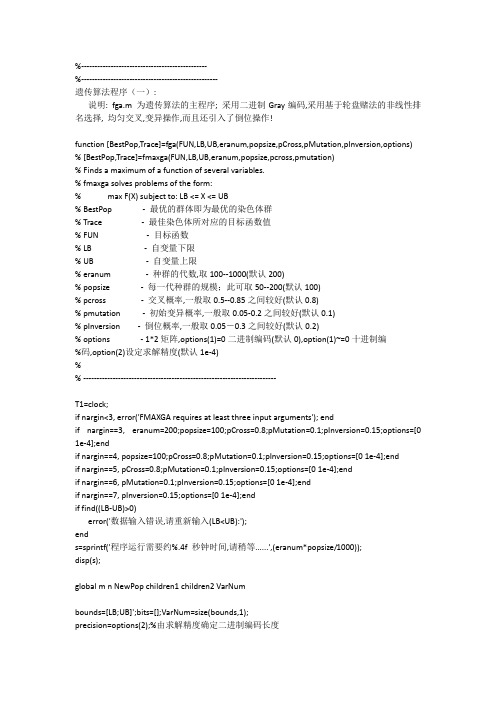
%-----------------------------------------------%---------------------------------------------------遗传算法程序(一):说明: fga.m 为遗传算法的主程序; 采用二进制Gray编码,采用基于轮盘赌法的非线性排名选择, 均匀交叉,变异操作,而且还引入了倒位操作!function [BestPop,Trace]=fga(FUN,LB,UB,eranum,popsize,pCross,pMutation,pInversion,options) % [BestPop,Trace]=fmaxga(FUN,LB,UB,eranum,popsize,pcross,pmutation)% Finds a maximum of a function of several variables.% fmaxga solves problems of the form:% max F(X) subject to: LB <= X <= UB% BestPop - 最优的群体即为最优的染色体群% Trace - 最佳染色体所对应的目标函数值% FUN - 目标函数% LB - 自变量下限% UB - 自变量上限% eranum - 种群的代数,取100--1000(默认200)% popsize - 每一代种群的规模;此可取50--200(默认100)% pcross - 交叉概率,一般取0.5--0.85之间较好(默认0.8)% pmutation - 初始变异概率,一般取0.05-0.2之间较好(默认0.1)% pInversion - 倒位概率,一般取0.05-0.3之间较好(默认0.2)% options - 1*2矩阵,options(1)=0二进制编码(默认0),option(1)~=0十进制编%码,option(2)设定求解精度(默认1e-4)%% ------------------------------------------------------------------------T1=clock;if nargin<3, error('FMAXGA requires at least three input arguments'); endif nargin==3, eranum=200;popsize=100;pCross=0.8;pMutation=0.1;pInversion=0.15;options=[0 1e-4];endif nargin==4, popsize=100;pCross=0.8;pMutation=0.1;pInversion=0.15;options=[0 1e-4];endif nargin==5, pCross=0.8;pMutation=0.1;pInversion=0.15;options=[0 1e-4];endif nargin==6, pMutation=0.1;pInversion=0.15;options=[0 1e-4];endif nargin==7, pInversion=0.15;options=[0 1e-4];endif find((LB-UB)>0)error('数据输入错误,请重新输入(LB<UB):');ends=sprintf('程序运行需要约%.4f 秒钟时间,请稍等......',(eranum*popsize/1000));disp(s);global m n NewPop children1 children2 VarNumbounds=[LB;UB]';bits=[];VarNum=size(bounds,1);precision=options(2);%由求解精度确定二进制编码长度bits=ceil(log2((bounds(:,2)-bounds(:,1))' ./ precision));%由设定精度划分区间[Pop]=InitPopGray(popsize,bits);%初始化种群[m,n]=size(Pop);NewPop=zeros(m,n);children1=zeros(1,n);children2=zeros(1,n);pm0=pMutation;BestPop=zeros(eranum,n);%分配初始解空间BestPop,TraceTrace=zeros(eranum,length(bits)+1);i=1;while i<=eranumfor j=1:mvalue(j)=feval(FUN(1,:),(b2f(Pop(j,:),bounds,bits)));%计算适应度end[MaxValue,Index]=max(value);BestPop(i,:)=Pop(Index,:);Trace(i,1)=MaxValue;Trace(i,(2:length(bits)+1))=b2f(BestPop(i,:),bounds,bits);[selectpop]=NonlinearRankSelect(FUN,Pop,bounds,bits);%非线性排名选择[CrossOverPop]=CrossOver(selectpop,pCross,round(unidrnd(eranum-i)/eranum));%采用多点交叉和均匀交叉,且逐步增大均匀交叉的概率%round(unidrnd(eranum-i)/eranum)[MutationPop]=Mutation(CrossOverPop,pMutation,VarNum);%变异[InversionPop]=Inversion(MutationPop,pInversion);%倒位Pop=InversionPop;%更新pMutation=pm0+(i^4)*(pCross/3-pm0)/(eranum^4);%随着种群向前进化,逐步增大变异率至1/2交叉率p(i)=pMutation;i=i+1;endt=1:eranum;plot(t,Trace(:,1)');title('函数优化的遗传算法');xlabel('进化世代数(eranum)');ylabel('每一代最优适应度(maxfitness)');[MaxFval,I]=max(Trace(:,1));X=Trace(I,(2:length(bits)+1));hold on; plot(I,MaxFval,'*');text(I+5,MaxFval,['FMAX=' num2str(MaxFval)]);str1=sprintf ('进化到%d 代,自变量为%s 时,得本次求解的最优值%f\n对应染色体是:%s',I,num2str(X),MaxFval,num2str(BestPop(I,:)));disp(str1);%figure(2);plot(t,p);%绘制变异值增大过程T2=clock;elapsed_time=T2-T1;if elapsed_time(6)<0elapsed_time(6)=elapsed_time(6)+60; elapsed_time(5)=elapsed_time(5)-1;endif elapsed_time(5)<0elapsed_time(5)=elapsed_time(5)+60;elapsed_time(4)=elapsed_time(4)-1;end %像这种程序当然不考虑运行上小时啦str2=sprintf('程序运行耗时%d 小时%d 分钟%.4f 秒',elapsed_time(4),elapsed_time(5),elapsed_time(6));disp(str2);%初始化种群%采用二进制Gray编码,其目的是为了克服二进制编码的Hamming悬崖缺点function [initpop]=InitPopGray(popsize,bits)len=sum(bits);initpop=zeros(popsize,len);%The whole zero encoding individualfor i=2:popsize-1pop=round(rand(1,len));pop=mod(([0 pop]+[pop 0]),2);%i=1时,b(1)=a(1);i>1时,b(i)=mod(a(i-1)+a(i),2)%其中原二进制串:a(1)a(2)...a(n),Gray串:b(1)b(2)...b(n)initpop(i,:)=pop(1:end-1);endinitpop(popsize,:)=ones(1,len);%The whole one encoding individual%%%%% %%%%%%%%%%%%%%%%%%%%%%%%%%%%%%%%%%%%%%%%%%%%%%%%%%%%%%% %%%%%%%%%%%%%%%%%%%%%%%%%%%%%%%%%%%%%%%%%%%%%%%%%%%%%%% %%解码function [fval] = b2f(bval,bounds,bits)% fval - 表征各变量的十进制数% bval - 表征各变量的二进制编码串% bounds - 各变量的取值范围% bits - 各变量的二进制编码长度scale=(bounds(:,2)-bounds(:,1))'./(2.^bits-1); %The range of the variablesnumV=size(bounds,1);cs=[0 cumsum(bits)];for i=1:numVa=bval((cs(i)+1):cs(i+1));fval(i)=sum(2.^(size(a,2)-1:-1:0).*a)*scale(i)+bounds(i,1);end%选择操作%采用基于轮盘赌法的非线性排名选择%各个体成员按适应值从大到小分配选择概率:%P(i)=(q/1-(1-q)^n)*(1-q)^i, 其中P(0)>P(1)>...>P(n), sum(P(i))=1function [selectpop]=NonlinearRankSelect(FUN,pop,bounds,bits)global m nselectpop=zeros(m,n);fit=zeros(m,1);for i=1:mfit(i)=feval(FUN(1,:),(b2f(pop(i,:),bounds,bits)));%以函数值为适应值做排名依据endselectprob=fit/sum(fit);%计算各个体相对适应度(0,1)q=max(selectprob);%选择最优的概率x=zeros(m,2);x(:,1)=[m:-1:1]';[y x(:,2)]=sort(selectprob);r=q/(1-(1-q)^m);%标准分布基值newfit(x(:,2))=r*(1-q).^(x(:,1)-1);%生成选择概率newfit=cumsum(newfit);%计算各选择概率之和rNums=sort(rand(m,1));fitIn=1;newIn=1;while newIn<=mif rNums(newIn)<newfit(fitIn)selectpop(newIn,:)=pop(fitIn,:);newIn=newIn+1;elsefitIn=fitIn+1;endend%交叉操作function [NewPop]=CrossOver(OldPop,pCross,opts)%OldPop为父代种群,pcross为交叉概率global m n NewPopr=rand(1,m);y1=find(r<pCross);y2=find(r>=pCross);len=length(y1);if len>2&mod(len,2)==1%如果用来进行交叉的染色体的条数为奇数,将其调整为偶数y2(length(y2)+1)=y1(len);y1(len)=[];endif length(y1)>=2for i=0:2:length(y1)-2if opts==0[NewPop(y1(i+1),:),NewPop(y1(i+2),:)]=EqualCrossOver(OldPop(y1(i+1),:),OldPop(y1(i+2),:));else[NewPop(y1(i+1),:),NewPop(y1(i+2),:)]=MultiPointCross(OldPop(y1(i+1),:),OldPop(y1(i+2),:));endendendNewPop(y2,:)=OldPop(y2,:);%采用均匀交叉function [children1,children2]=EqualCrossOver(parent1,parent2)global n children1 children2hidecode=round(rand(1,n));%随机生成掩码crossposition=find(hidecode==1);holdposition=find(hidecode==0);children1(crossposition)=parent1(crossposition);%掩码为1,父1为子1提供基因children1(holdposition)=parent2(holdposition);%掩码为0,父2为子1提供基因children2(crossposition)=parent2(crossposition);%掩码为1,父2为子2提供基因children2(holdposition)=parent1(holdposition);%掩码为0,父1为子2提供基因%采用多点交叉,交叉点数由变量数决定function [Children1,Children2]=MultiPointCross(Parent1,Parent2)global n Children1 Children2 VarNumChildren1=Parent1;Children2=Parent2;Points=sort(unidrnd(n,1,2*VarNum));for i=1:VarNumChildren1(Points(2*i-1):Points(2*i))=Parent2(Points(2*i-1):Points(2*i));Children2(Points(2*i-1):Points(2*i))=Parent1(Points(2*i-1):Points(2*i));end%变异操作function [NewPop]=Mutation(OldPop,pMutation,VarNum)global m n NewPopr=rand(1,m);position=find(r<=pMutation);len=length(position);if len>=1for i=1:lenk=unidrnd(n,1,VarNum); %设置变异点数,一般设置1点for j=1:length(k)if OldPop(position(i),k(j))==1OldPop(position(i),k(j))=0;elseOldPop(position(i),k(j))=1;endendendendNewPop=OldPop;%%%%%%%%%%%%%%%%%%%%%%%%%%%%%%%%%%%%%%%%%%%%%%%%%%%%%%% %%%%%%%%%%%%%%%%%%%%%%%%%%%%%%%%%%%%%%%%%%%%%%%%%%%%%%% %%%%%%%%%%%倒位操作function [NewPop]=Inversion(OldPop,pInversion)global m n NewPopNewPop=OldPop;r=rand(1,m);PopIn=find(r<=pInversion);len=length(PopIn);if len>=1for i=1:lend=sort(unidrnd(n,1,2));if d(1)~=1&d(2)~=nNewPop(PopIn(i),1:d(1)-1)=OldPop(PopIn(i),1:d(1)-1);NewPop(PopIn(i),d(1):d(2))=OldPop(PopIn(i),d(2):-1:d(1));NewPop(PopIn(i),d(2)+1:n)=OldPop(PopIn(i),d(2)+1:n);endendend遗传算法程序(二):function youhuafunD=code;N=50; % Tunablemaxgen=50; % Tunablecrossrate=0.5; %Tunablemuterate=0.08; %Tunablegeneration=1;num = length(D);fatherrand=randint(num,N,3);score = zeros(maxgen,N);while generation<=maxgenind=randperm(N-2)+2; % 随机配对交叉A=fatherrand(:,ind(1:(N-2)/2));B=fatherrand(:,ind((N-2)/2+1:end));% 多点交叉rnd=rand(num,(N-2)/2);ind=rnd tmp=A(ind);A(ind)=B(ind);B(ind)=tmp;% % 两点交叉% for kk=1:(N-2)/2% rndtmp=randint(1,1,num)+1;% tmp=A(1:rndtmp,kk);% A(1:rndtmp,kk)=B(1:rndtmp,kk);% B(1:rndtmp,kk)=tmp;% endfatherrand=[fatherrand(:,1:2),A,B];% 变异rnd=rand(num,N);ind=rnd [m,n]=size(ind);tmp=randint(m,n,2)+1;tmp(:,1:2)=0;fatherrand=tmp+fatherrand;fatherrand=mod(fatherrand,3);% fatherrand(ind)=tmp;%评价、选择scoreN=scorefun(fatherrand,D);% 求得N个个体的评价函数score(generation,:)=scoreN;[scoreSort,scoreind]=sort(scoreN);sumscore=cumsum(scoreSort);sumscore=sumscore./sumscore(end);childind(1:2)=scoreind(end-1:end);for k=3:Ntmprnd=rand;tmpind=tmprnd difind=[0,diff(tmpind)];if ~any(difind)difind(1)=1;endchildind(k)=scoreind(logical(difind));endfatherrand=fatherrand(:,childind);generation=generation+1;end% scoremaxV=max(score,[],2);minV=11*300-maxV;plot(minV,'*');title('各代的目标函数值');F4=D(:,4);FF4=F4-fatherrand(:,1);FF4=max(FF4,1);D(:,5)=FF4;save DData Dfunction D=codeload youhua.mat% properties F2 and F3F1=A(:,1);F2=A(:,2);F3=A(:,3);if (max(F2)>1450)||(min(F2)<=900)error('DATA property F2 exceed it''s range (900,1450]')end% get group property F1 of data, according to F2 valueF4=zeros(size(F1));for ite=11:-1:1index=find(F2<=900+ite*50);F4(index)=ite;endD=[F1,F2,F3,F4];function ScoreN=scorefun(fatherrand,D)F3=D(:,3);F4=D(:,4);N=size(fatherrand,2);FF4=F4*ones(1,N);FF4rnd=FF4-fatherrand;FF4rnd=max(FF4rnd,1);ScoreN=ones(1,N)*300*11;% 这里有待优化for k=1:NFF4k=FF4rnd(:,k);for ite=1:11F0index=find(FF4k==ite);if ~isempty(F0index)tmpMat=F3(F0index);tmpSco=sum(tmpMat);ScoreBin(ite)=mod(tmpSco,300);endendScorek(k)=sum(ScoreBin);endScoreN=ScoreN-Scorek;%%%%%%%%%%%%%%%%%%%%%%%%%%%%%%%%%%%%%%%%%%%%%%%%%%%%%%% %%%%%%%%%%%%%%%%%%%%%%%%%%%%%%%%%%%%%%%%%%%%%%%%%%%%%%% %%%%%%%%%%遗传算法程序(三):%IAGAfunction best=gaclearMAX_gen=200; %最大迭代步数best.max_f=0; %当前最大的适应度STOP_f=14.5; %停止循环的适应度RANGE=[0 255]; %初始取值范围[0 255]SPEEDUP_INTER=5; %进入加速迭代的间隔advance_k=0; %优化的次数popus=init; %初始化for gen=1:MAX_genfitness=fit(popus,RANGE); %求适应度f=fitness.f;picked=choose(popus,fitness); %选择popus=intercross(popus,picked); %杂交popus=aberrance(popus,picked); %变异if max(f)>best.max_fadvance_k=advance_k+1;x_better(advance_k)=fitness.x;best.max_f=max(f);best.popus=popus;best.x=fitness.x;endif mod(advance_k,SPEEDUP_INTER)==0RANGE=minmax(x_better);RANGEadvance=0;endendreturn;function popus=init%初始化M=50;%种群个体数目N=30;%编码长度popus=round(rand(M,N));return;function fitness=fit(popus,RANGE)%求适应度[M,N]=size(popus);fitness=zeros(M,1);%适应度f=zeros(M,1);%函数值A=RANGE(1);B=RANGE(2);%初始取值范围[0 255]for m=1:Mx=0;for n=1:Nx=x+popus(m,n)*(2^(n-1));endx=x*((B-A)/(2^N))+A;for k=1:5f(m,1)=f(m,1)-(k*sin((k+1)*x+k));endendf_std=(f-min(f))./(max(f)-min(f));%函数值标准化fitness.f=f;fitness.f_std=f_std;fitness.x=x;return;function picked=choose(popus,fitness)%选择f=fitness.f;f_std=fitness.f_std;[M,N]=size(popus);choose_N=3; %选择choose_N对双亲picked=zeros(choose_N,2); %记录选择好的双亲p=zeros(M,1); %选择概率d_order=zeros(M,1);%把父代个体按适应度从大到小排序f_t=sort(f,'descend');%将适应度按降序排列for k=1:Mx=find(f==f_t(k));%降序排列的个体序号d_order(k)=x(1);endfor m=1:Mpopus_t(m,:)=popus(d_order(m),:);endpopus=popus_t;f=f_t;p=f_std./sum(f_std); %选择概率c_p=cumsum(p)'; %累积概率for cn=1:choose_Npicked(cn,1)=roulette(c_p); %轮盘赌picked(cn,2)=roulette(c_p); %轮盘赌popus=intercross(popus,picked(cn,:));%杂交endpopus=aberrance(popus,picked);%变异return;function popus=intercross(popus,picked) %杂交[M_p,N_p]=size(picked);[M,N]=size(popus);for cn=1:M_pp(1)=ceil(rand*N);%生成杂交位置p(2)=ceil(rand*N);p=sort(p);t=popus(picked(cn,1),p(1):p(2));popus(picked(cn,1),p(1):p(2))=popus(picked(cn,2),p(1):p(2));popus(picked(cn,2),p(1):p(2))=t;endreturn;function popus=aberrance(popus,picked) %变异P_a=0.05;%变异概率[M,N]=size(popus);[M_p,N_p]=size(picked);U=rand(1,2);for kp=1:M_pif U(2)>=P_a %如果大于变异概率,就不变异continue;endif U(1)>=0.5a=picked(kp,1);elsea=picked(kp,2);endp(1)=ceil(rand*N);%生成变异位置p(2)=ceil(rand*N);if popus(a,p(1))==1%0 1变换popus(a,p(1))=0;elsepopus(a,p(1))=1;endif popus(a,p(2))==1popus(a,p(2))=0;elsepopus(a,p(2))=1;endendreturn;function picked=roulette(c_p) %轮盘赌[M,N]=size(c_p);M=max([M N]);U=rand;if U<c_p(1)picked=1;return;endfor m=1:(M-1)if U>c_p(m) & U<c_p(m+1)picked=m+1;break;endend全方位的两点杂交、两点变异的改进的加速遗传算法(IAGA)%%%%%%%%%%%%%%%%%%%%%%%%%%%%%%%%%%%%%%%%%%%%%%%%%%%%%%% %%%%%%%%%%%%%%%%%%%%%%%%%%%%%%%%%%%%%%%%%%%%%%%%%%%%%%% %%%%%%%%%% %%%%%%%%%%%%%%%%%%%%%%%%%%%%%%%%%%%%%%%%%%%%%%%%%%%%%%% %%%%%%%%%%%%%%%%%%%%%%%%%%%%%%%%%%%%%%%%%%%%%%%%%%%%%%% %%%%%%%%%% %%%%%%%%%%%%%%%%%%%%%%%%%%%%%%%%%%%%%%%%%%%%%%%%%%%%%%% %%%%%%%%%%%%%%%%%%%%%%%%%%%%%%%%%%%%%%%%%%%%%%%%%%%%%%% %%%%%%%%%% %%%%%%%%%%%%%%%%%%%%%%%%%%%%%%%%%%%%%%%%%%%%%%%%%%%%%%% %%%%%%%%%%%%%%%%%%%%%%%%%%%%%%%%%%%%%%%%%%%%%%%%%%%%%%% %%%%%%%%%%。
使用MATLAB遗传算法工具实例
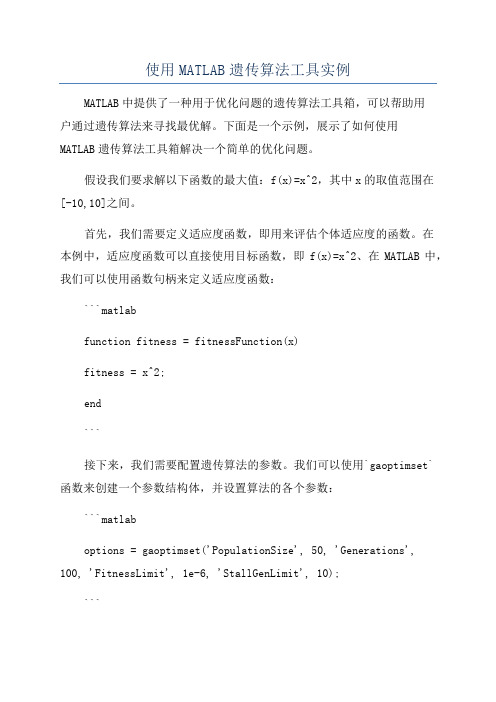
使用MATLAB遗传算法工具实例MATLAB中提供了一种用于优化问题的遗传算法工具箱,可以帮助用户通过遗传算法来寻找最优解。
下面是一个示例,展示了如何使用MATLAB遗传算法工具箱解决一个简单的优化问题。
假设我们要求解以下函数的最大值:f(x)=x^2,其中x的取值范围在[-10,10]之间。
首先,我们需要定义适应度函数,即用来评估个体适应度的函数。
在本例中,适应度函数可以直接使用目标函数,即f(x)=x^2、在MATLAB中,我们可以使用函数句柄来定义适应度函数:```matlabfunction fitness = fitnessFunction(x)fitness = x^2;end```接下来,我们需要配置遗传算法的参数。
我们可以使用`gaoptimset`函数来创建一个参数结构体,并设置算法的各个参数:```matlaboptions = gaoptimset('PopulationSize', 50, 'Generations', 100, 'FitnessLimit', 1e-6, 'StallGenLimit', 10);```上述代码将设置种群大小为50,迭代次数为100,适应度极限为1e-6(即当适应度较小时停止迭代),最大迭代代数为10(即如果连续10代迭代没有改进,则停止迭代)。
接下来,我们需要调用`ga`函数来运行遗传算法并求解最优解。
我们可以使用以下代码来实现:```matlab```最后,我们可以打印出最优解及其目标函数值:```matlabdisp(['Optimal solution: x = ' num2str(x) ', f(x) = 'num2str(fval)]);```上述代码中,`num2str`函数用于将数字转换为字符串,然后使用`disp`函数打印出最优解和目标函数值。
遗传算法在matlab中的实现
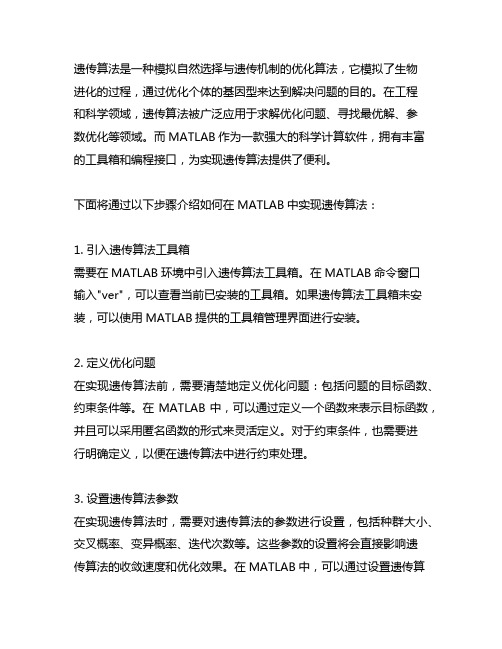
遗传算法是一种模拟自然选择与遗传机制的优化算法,它模拟了生物进化的过程,通过优化个体的基因型来达到解决问题的目的。
在工程和科学领域,遗传算法被广泛应用于求解优化问题、寻找最优解、参数优化等领域。
而MATLAB作为一款强大的科学计算软件,拥有丰富的工具箱和编程接口,为实现遗传算法提供了便利。
下面将通过以下步骤介绍如何在MATLAB中实现遗传算法:1. 引入遗传算法工具箱需要在MATLAB环境中引入遗传算法工具箱。
在MATLAB命令窗口输入"ver",可以查看当前已安装的工具箱。
如果遗传算法工具箱未安装,可以使用MATLAB提供的工具箱管理界面进行安装。
2. 定义优化问题在实现遗传算法前,需要清楚地定义优化问题:包括问题的目标函数、约束条件等。
在MATLAB中,可以通过定义一个函数来表示目标函数,并且可以采用匿名函数的形式来灵活定义。
对于约束条件,也需要进行明确定义,以便在遗传算法中进行约束处理。
3. 设置遗传算法参数在实现遗传算法时,需要对遗传算法的参数进行设置,包括种群大小、交叉概率、变异概率、迭代次数等。
这些参数的设置将会直接影响遗传算法的收敛速度和优化效果。
在MATLAB中,可以通过设置遗传算法工具箱中的相关函数来完成参数的设置。
4. 编写遗传算法主程序编写遗传算法的主程序,主要包括对适应度函数的计算、选择、交叉、变异等操作。
在MATLAB中,可以利用遗传算法工具箱提供的相关函数来实现这些操作,简化了遗传算法的实现过程。
5. 运行遗传算法将编写好的遗传算法主程序在MATLAB环境中运行,并观察优化结果。
在运行过程中,可以对结果进行实时监测和分析,以便对遗传算法的参数进行调整和优化。
通过以上步骤,可以在MATLAB中实现遗传算法,并应用于实际的优化问题与工程应用中。
遗传算法的实现将大大提高问题的求解效率与精度,为工程领域带来更多的便利与可能性。
总结:遗传算法在MATLAB中的实现涉及到了引入遗传算法工具箱、定义优化问题、设置算法参数、编写主程序和运行算法等步骤。
完整的遗传算法函数Matlab程序【精品毕业设计】(完整版)
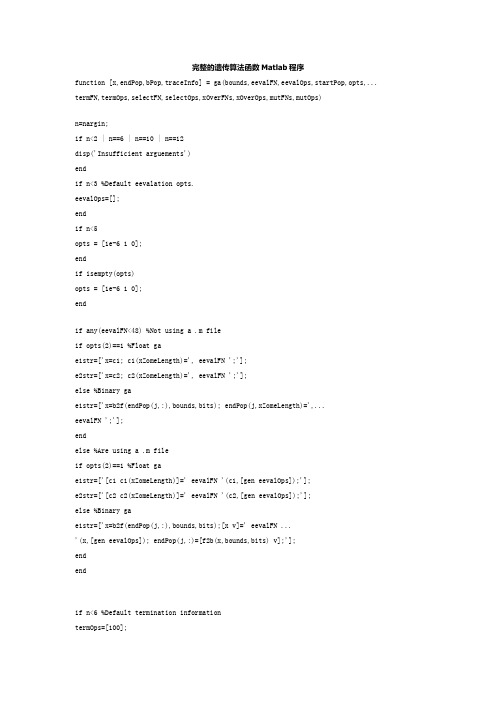
完整的遗传算法函数Matlab程序function [x,endPop,bPop,traceInfo] = ga(bounds,eevalFN,eevalOps,startPop,opts,... termFN,termOps,selectFN,selectOps,xOverFNs,xOverOps,mutFNs,mutOps)n=nargin;if n<2 | n==6 | n==10 | n==12disp('Insufficient arguements')endif n<3 %Default eevalation opts.eevalOps=[];endif n<5opts = [1e-6 1 0];endif isempty(opts)opts = [1e-6 1 0];endif any(eevalFN<48) %Not using a .m fileif opts(2)==1 %Float gae1str=['x=c1; c1(xZomeLength)=', eevalFN ';'];e2str=['x=c2; c2(xZomeLength)=', eevalFN ';'];else %Binary gae1str=['x=b2f(endPop(j,:),bounds,bits); endPop(j,xZomeLength)=',...eevalFN ';'];endelse %Are using a .m fileif opts(2)==1 %Float gae1str=['[c1 c1(xZomeLength)]=' eevalFN '(c1,[gen eevalOps]);'];e2str=['[c2 c2(xZomeLength)]=' eevalFN '(c2,[gen eevalOps]);'];else %Binary gae1str=['x=b2f(endPop(j,:),bounds,bits);[x v]=' eevalFN ...'(x,[gen eevalOps]); endPop(j,:)=[f2b(x,bounds,bits) v];'];endendif n<6 %Default termination informationtermOps=[100];termFN='maxGenTerm';endif n<12 %Default muatation informationif opts(2)==1 %Float GAmutFNs=['boundaryMutation multiNonUnifMutation nonUnifMutation unifMutation']; mutOps=[4 0 0;6 termOps(1) 3;4 termOps(1) 3;4 0 0];else %Binary GAmutFNs=['binaryMutation'];mutOps=[0.05];endendif n<10 %默认的交叉信息if opts(2)==1 %浮点编码xOverFNs=['arithXover heuristicXover simpleXover'];xOverOps=[2 0;2 3;2 0];else %Binary GAxOverFNs=['simpleXover'];xOverOps=[0.6];endendif n<9 %Default select opts only i.e. roullete wheel.selectOps=[];endif n<8 %Default select infoselectFN=['normGeomSelect'];selectOps=[0.08];endif n<6 %默认的算法终止准则termOps=[100];termFN='maxGenTerm';endif n<4 %初始种群为空startPop=[];endif isempty(startPop) %随机生成初始种群startPop=initializega(80,bounds,eevalFN,eevalOps,opts(1:2));endif opts(2)==0 %二进制编码bits=calcbits(bounds,opts(1));endxOverFNs=parse(xOverFNs);mutFNs=parse(mutFNs);xZomeLength = size(startPop,2); %Length of the xzome=numVars+fittness numVar = xZomeLength-1; %变量数目popSize = size(startPop,1); %种群中个体数目endPop = zeros(popSize,xZomeLength); %次种群矩阵c1 = zeros(1,xZomeLength); %个体c2 = zeros(1,xZomeLength); %个体numXOvers = size(xOverFNs,1); %交叉操作次数numMuts = size(mutFNs,1); %变异操作次数epsilon = opts(1); %适应度门限值oeval = max(startPop(:,xZomeLength)); %初始种群中的最优值bFoundIn = 1;done = 0;gen = 1;collectTrace = (nargout>3);floatGA = opts(2)==1;display = opts(3);while(~done)[beval,bindx] = max(startPop(:,xZomeLength)); %当前种群的最优值best = startPop(bindx,:);if collectTracetraceInfo(gen,1)=gen; %当前代traceInfo(gen,2)=startPop(bindx,xZomeLength); %最优适应度traceInfo(gen,3)=mean(startPop(:,xZomeLength)); %平均适应度traceInfo(gen,4)=std(startPop(:,xZomeLength));endif ( (abs(beval - oeval)>epsilon) | (gen==1))if displayfprintf(1,'\n%d %f\n',gen,beval);endif floatGAbPop(bFoundIn,:)=[gen startPop(bindx,:)];elsebPop(bFoundIn,:)=[gen b2f(startPop(bindx,1:numVar),bounds,bits)... startPop(bindx,xZomeLength)];endbFoundIn=bFoundIn+1;oeval=beval;elseif displayfprintf(1,'%d ',gen);endendendPop = feeval(selectFN,startPop,[gen selectOps]); %选择操作if floatGAfor i=1:numXOvers,for j=1:xOverOps(i,1),a = round(rand*(popSize-1)+1); %一个父代个体b = round(rand*(popSize-1)+1); %另一个父代个体xN=deblank(xOverFNs(i,:)); %交叉函数[c1 c2] = feeval(xN,endPop(a,:),endPop(b,:),bounds,[gen… xOverOps(i,:)]);if c1(1:numVar)==endPop(a,(1:numVar))c1(xZomeLength)=endPop(a,xZomeLength);elseif c1(1:numVar)==endPop(b,(1:numVar))c1(xZomeLength)=endPop(b,xZomeLength);elseeeval(e1str);endif c2(1:numVar)==endPop(a,(1:numVar))c2(xZomeLength)=endPop(a,xZomeLength);elseif c2(1:numVar)==endPop(b,(1:numVar))c2(xZomeLength)=endPop(b,xZomeLength);elseeeval(e2str);endendPop(a,:)=c1;endPop(b,:)=c2;endendfor i=1:numMuts,for j=1:mutOps(i,1),a = round(rand*(popSize-1)+1);c1 = feeval(deblank(mutFNs(i,:)),endPop(a,:),bounds,[gen mutOps(i,:)]);if c1(1:numVar)==endPop(a,(1:numVar))c1(xZomeLength)=endPop(a,xZomeLength);elseeeval(e1str);endendPop(a,:)=c1;endendelse %遗传操作的统计模型for i=1:numXOvers,xN=deblank(xOverFNs(i,:));cp=find(rand(popSize,1)if rem(size(cp,1),2) cp=cp(1:(size(cp,1)-1)); endcp=reshape(cp,size(cp,1)/2,2);for j=1:size(cp,1)a=cp(j,1); b=cp(j,2);[endPop(a,:) endPop(b,:)] = feeval(xN,endPop(a,:),endPop(b,:), bounds,[gen xOverOps(i,:)]); endendfor i=1:numMutsmN=deblank(mutFNs(i,:));for j=1:popSizeendPop(j,:) = feeval(mN,endPop(j,:),bounds,[gen mutOps(i,:)]);eeval(e1str);endendend。
遗传算法matlab代码
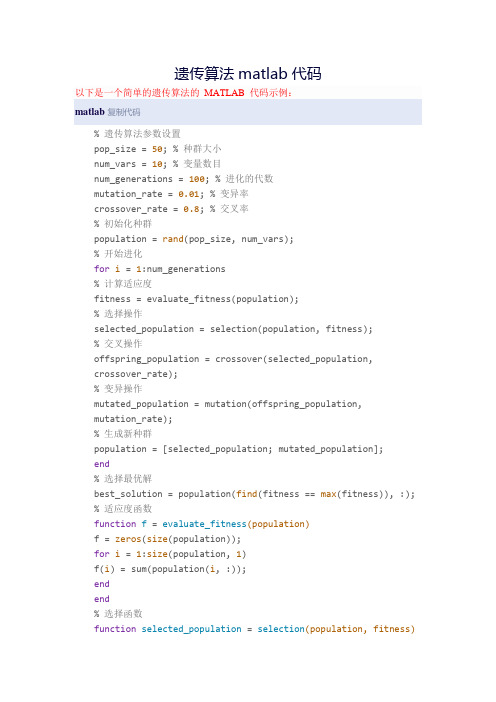
遗传算法matlab代码以下是一个简单的遗传算法的MATLAB 代码示例:matlab复制代码% 遗传算法参数设置pop_size = 50; % 种群大小num_vars = 10; % 变量数目num_generations = 100; % 进化的代数mutation_rate = 0.01; % 变异率crossover_rate = 0.8; % 交叉率% 初始化种群population = rand(pop_size, num_vars);% 开始进化for i = 1:num_generations% 计算适应度fitness = evaluate_fitness(population);% 选择操作selected_population = selection(population, fitness);% 交叉操作offspring_population = crossover(selected_population,crossover_rate);% 变异操作mutated_population = mutation(offspring_population,mutation_rate);% 生成新种群population = [selected_population; mutated_population];end% 选择最优解best_solution = population(find(fitness == max(fitness)), :);% 适应度函数function f = evaluate_fitness(population)f = zeros(size(population));for i = 1:size(population, 1)f(i) = sum(population(i, :));endend% 选择函数function selected_population = selection(population, fitness)% 轮盘赌选择total_fitness = sum(fitness);probabilities = fitness / total_fitness;selected_indices = zeros(pop_size, 1);for i = 1:pop_sizer = rand();cumulative_probabilities = cumsum(probabilities);for j = 1:pop_sizeif r <= cumulative_probabilities(j)selected_indices(i) = j;break;endendendselected_population = population(selected_indices, :);end% 交叉函数function offspring_population = crossover(parental_population, crossover_rate)offspring_population = zeros(size(parental_population));num_crossovers = ceil(size(parental_population, 1) *crossover_rate);crossover_indices = randperm(size(parental_population, 1),num_crossovers);以下是另一个一个简单的遗传算法的MATLAB 代码示例:matlab复制代码% 初始化种群population = rand(nPopulation, nGenes);% 进化迭代for iGeneration = 1:nGeneration% 计算适应度fitness = evaluateFitness(population);% 选择父代parentIdx = selection(fitness);parent = population(parentIdx, :);% 交叉产生子代child = crossover(parent);% 变异子代child = mutation(child);% 更新种群population = [parent; child];end% 评估最优解bestFitness = -Inf;for i = 1:nPopulationf = evaluateFitness(population(i, :));if f > bestFitnessbestFitness = f;bestIndividual = population(i, :);endend% 可视化结果plotFitness(fitness);其中,nPopulation和nGenes分别是种群大小和基因数;nGeneration是迭代次数;evaluateFitness函数用于计算个体的适应度;selection函数用于选择父代;crossover函数用于交叉产生子代;mutation函数用于变异子代。
(完整版)遗传算法matlab实现源程序
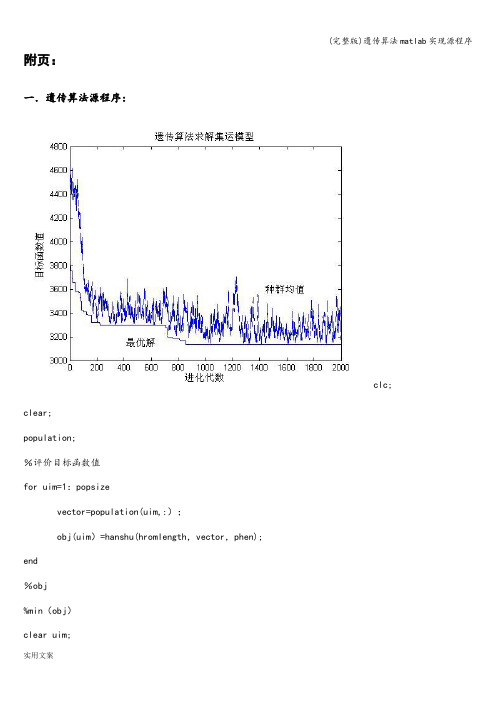
附页:一.遗传算法源程序:clc; clear;population;%评价目标函数值for uim=1:popsizevector=population(uim,:);obj(uim)=hanshu(hromlength,vector,phen);end%obj%min(obj)clear uim;objmin=min(obj);for sequ=1:popsizeif obj(sequ)==objminopti=population(sequ,:);endendclear sequ;fmax=22000;%==for gen=1:maxgen%选择操作%将求最小值的函数转化为适应度函数for indivi=1:popsizeobj1(indivi)=1/obj(indivi);endclear indivi;%适应度函数累加总合total=0;for indivi=1:popsizetotal=total+obj1(indivi);endclear indivi;%每条染色体被选中的几率for indivi=1:popsizefitness1(indivi)=obj1(indivi)/total;endclear indivi;%各条染色体被选中的范围for indivi=1:popsizefitness(indivi)=0;for j=1:indivifitness(indivi)=fitness(indivi)+fitness1(j);endendclear j;fitness;%选择适应度高的个体for ranseti=1:popsizeran=rand;while (ran>1||ran<0)ran=rand;endran;if ran〈=fitness(1)newpopulation(ranseti,:)=population(1,:);elsefor fet=2:popsizeif (ran〉fitness(fet—1))&&(ran<=fitness(fet))newpopulation(ranseti,:)=population(fet,:);endendendendclear ran;newpopulation;%交叉for int=1:2:popsize-1popmoth=newpopulation(int,:);popfath=newpopulation(int+1,:);popcross(int,:)=popmoth;popcross(int+1,:)=popfath;randnum=rand;if(randnum〈 P>cpoint1=round(rand*hromlength);cpoint2=round(rand*hromlength);while (cpoint2==cpoint1)cpoint2=round(rand*hromlength);endif cpoint1>cpoint2tem=cpoint1;cpoint1=cpoint2;cpoint2=tem;endcpoint1;cpoint2;for term=cpoint1+1:cpoint2for ss=1:hromlengthif popcross(int,ss)==popfath(term)tem1=popcross(int,ss);popcross(int,ss)=popcross(int,term);popcross(int,term)=tem1;endendclear tem1;endfor term=cpoint1+1:cpoint2for ss=1:hromlengthif popcross(int+1,ss)==popmoth(term)tem1=popcross(int+1,ss);popcross(int+1,ss)=popcross(int+1,term);popcross(int+1,term)=tem1;endendclear tem1;endendclear term;endclear randnum;popcross;%变异操作newpop=popcross;for int=1:popsizerandnum=rand;if randnumcpoint12=round(rand*hromlength);cpoint22=round(rand*hromlength);if (cpoint12==0)cpoint12=1;endif (cpoint22==0)cpoint22=1;endwhile (cpoint22==cpoint12)cpoint22=round(rand*hromlength);if cpoint22==0;cpoint22=1;endendtemp=newpop(int,cpoint12);newpop(int,cpoint12)=newpop(int,cpoint22);newpop(int,cpoint22)=temp;。
遗传算法 matlab程序

遗传算法 matlab程序遗传算法(Genetic Algorithm)是一种模拟生物进化过程的优化算法,主要用于解决复杂的优化问题。
在这篇文章中,我们将介绍如何使用MATLAB编写遗传算法的程序,并展示其在实际问题中的应用。
我们需要明确遗传算法的基本原理。
遗传算法通过模拟自然选择、交叉和变异等基因操作,以产生新的解,并通过适应度函数评估每个解的优劣。
通过不断迭代,遗传算法逐渐找到最优解。
在MATLAB中,我们可以使用遗传算法工具箱来实现遗传算法的程序。
首先,我们需要定义问题的目标函数和约束条件。
目标函数是我们希望优化的函数,而约束条件则是问题的限制条件。
在定义完目标函数和约束条件后,我们可以使用遗传算法工具箱中的函数来构建遗传算法的程序。
在遗传算法中,每个解都可以看作一个个体,而每个个体都由一串基因表示。
在MATLAB中,我们可以用一个二进制字符串来表示一个个体。
例如,一个8位的二进制字符串可以表示一个整数值或一个实数值。
在遗传算法中,这个二进制字符串称为染色体。
在遗传算法的程序中,我们需要定义染色体的编码方式、交叉方式、变异方式等。
编码方式决定了染色体的表示方法,常见的编码方式有二进制编码和实数编码。
交叉方式决定了如何将两个染色体进行交叉操作,常见的交叉方式有单点交叉和多点交叉。
变异方式决定了如何对染色体进行变异操作,常见的变异方式有位变异和基因变异。
在编写遗传算法的程序时,我们需要定义适应度函数来评估每个个体的优劣。
适应度函数的值越大,说明个体的优势越大。
根据适应度函数的值,我们可以选择一些优秀的个体进行交叉和变异操作,以产生新的解。
在MATLAB中,我们可以使用遗传算法工具箱中的函数来进行遗传算法的迭代过程。
通过设置迭代次数和种群大小等参数,我们可以控制算法的运行过程。
在每次迭代中,遗传算法会根据适应度函数的值选择一些优秀的个体,进行交叉和变异操作,以产生新的解。
经过多次迭代后,遗传算法会逐渐找到最优解。
matlab智能算法代码
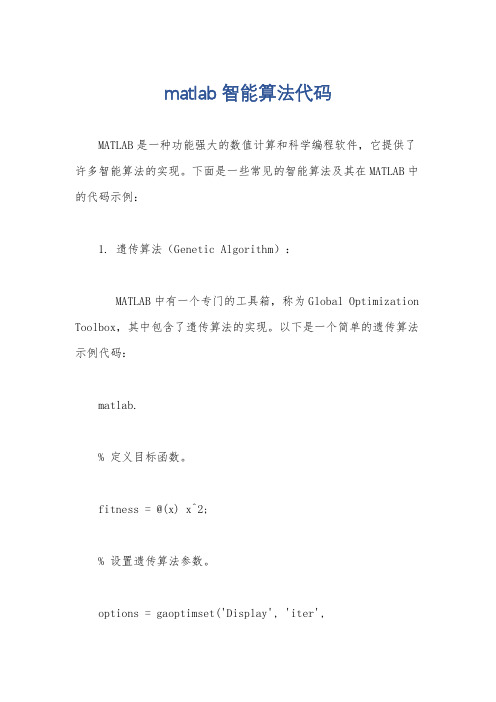
matlab智能算法代码MATLAB是一种功能强大的数值计算和科学编程软件,它提供了许多智能算法的实现。
下面是一些常见的智能算法及其在MATLAB中的代码示例:1. 遗传算法(Genetic Algorithm):MATLAB中有一个专门的工具箱,称为Global Optimization Toolbox,其中包含了遗传算法的实现。
以下是一个简单的遗传算法示例代码:matlab.% 定义目标函数。
fitness = @(x) x^2;% 设置遗传算法参数。
options = gaoptimset('Display', 'iter','PopulationSize', 50);% 运行遗传算法。
[x, fval] = ga(fitness, 1, options);2. 粒子群优化算法(Particle Swarm Optimization):MATLAB中也有一个工具箱,称为Global Optimization Toolbox,其中包含了粒子群优化算法的实现。
以下是一个简单的粒子群优化算法示例代码:matlab.% 定义目标函数。
fitness = @(x) x^2;% 设置粒子群优化算法参数。
options = optimoptions('particleswarm', 'Display','iter', 'SwarmSize', 50);% 运行粒子群优化算法。
[x, fval] = particleswarm(fitness, 1, [], [], options);3. 支持向量机(Support Vector Machine):MATLAB中有一个机器学习工具箱,称为Statistics and Machine Learning Toolbox,其中包含了支持向量机的实现。
- 1、下载文档前请自行甄别文档内容的完整性,平台不提供额外的编辑、内容补充、找答案等附加服务。
- 2、"仅部分预览"的文档,不可在线预览部分如存在完整性等问题,可反馈申请退款(可完整预览的文档不适用该条件!)。
- 3、如文档侵犯您的权益,请联系客服反馈,我们会尽快为您处理(人工客服工作时间:9:00-18:30)。
function [pso F] = PSO_2D()% FUNCTION PSO --------USE Particle Swarm Optimization Algorithm%global present;% close all;pop_size = 10; % pop_size 种群大小part_size = 2; % part_size 粒子大小, ** =n-Dgbest = zeros(1,part_size+1); % gbest 当前搜索到的最小的值max_gen = 80; % max_gen 最大迭代次数region=zeros(part_size,2); % 设定搜索空间范围region=[-3,3;-3,3]; % **每一维设定不同范围rand('state',sum(100*clock)); % 重置随机数发生器状态arr_present = ini_pos(pop_size,part_size); % present 当前位置,随机初始化,rand()的范围为0~1v=ini_v(pop_size,part_size); % 初始化当前速度pbest = zeros(pop_size,part_size+1); % pbest 粒子以前搜索到的最优值,最后一列包括这些值的适应度w_max = 0.9; % w_max 权系数最大值w_min = 0.4;v_max = 2; % **最大速度,为粒子的范围宽度c1 = 2; % 学习因子c2 = 2; % 学习因子best_record = zeros(1,max_gen); % best_record记录最好的粒子的适应度。
% ————————————————————————% 计算原始种群的适应度,及初始化% ————————————————————————arr_present(:,end)=ini_fit(arr_present,pop_size,part_size);% for k=1:pop_size% present(k,end) = fitness(present(k,1:part_size)); %计算原始种群的适应度% endpbest = arr_present; %初始化各个粒子最优值[best_value best_index] = min(arr_present(:,end)); %初始化全局最优,即适应度为全局最小的值,根据需要也可以选取为最大值gbest = arr_present(best_index,:);%v = zeros(pop_size,1); % v 速度% ————————————————————————% 迭代% ————————————————————————% global m;% m = moviein(1000); %生成帧矩阵x=[-3:0.01:3];y=[-3:0.01:3];z=@(x,y) 3*(1-x).^2.*exp(-(x.^2) - (y+1).^2) ...- 10*(x/5 - x.^3 - y.^5).*exp(-x.^2-y.^2) ...- 1/3*exp(-(x+1).^2 - y.^2);for i=1:max_gengrid on;plot3(x,y,z);% subplot(121),ezmesh(z),hold on,grid on,plot3(arr_present(:,1),arr_present(:,2),arr_present(:,3),'*'),hold off;% subplot(122),ezmesh(z),view([145,90]),hold on,grid on,plot3(arr_present(:,1),arr_present(:,2),arr_present(:,3),'*'),hold off;ezmesh(z),hold on,grid on,plot3(arr_present(:,1),arr_present(:,2),arr_present(:,3),'*'),hold off;drawnowF(i)=getframe;% ezmesh(z)% % view([-37,90])% hold on;% grid on;% % plot(-0.0898,0.7126,'ro');%plot3(arr_present(:,1),arr_present(:,2),arr_present(:,3),'*');%改为三维% axis([-2*pi,2*pi,-pi,pi,-50,10]);% hold off;pause(0.01);% m(:,i) = getframe; %添加图形w = w_max-(w_max-w_min)*i/max_gen;% fprintf('# %i 代开始!\n',i);% 确定是否对打散已经收敛的粒子群——————————————————————————————reset = 0; % reset = 1时设置为粒子群过分收敛时将其打散,如果=1则不打散if reset==1bit = 1;for k=1:part_sizebit = bit&(range(arr_present(:,k))<0.1);endif bit==1 % bit=1时对粒子位置及速度进行随机重置arr_present = ini_pos(pop_size,part_size); % present 当前位置,随机初始化v = ini_v(pop_size,part_size); % 速度初始化for k=1:pop_size % 重新计算适应度arr_present(k,end) = fitness(arr_present(k,1:part_size));endwarning('粒子过分集中!重新初始化……'); % 给出信息display(i);endendfor j=1:pop_sizev(j,:) = w.*v(j,:)+c1.*rand.*(pbest(j,1:part_size)-arr_present(j,1:part_size))...+c2.*rand.*(gbest(1:part_size)-arr_present(j,1:part_size)); % 粒子速度更新(a)% 判断v的大小,限制v的绝对值小于5————————————————————————————c = find(abs(v)>6);%**最大速度设置,粒子的范围宽度v(c) = sign(v(c))*6; %如果速度大于3.14则,速度为3.14arr_present(j,1:part_size) = arr_present(j,1:part_size)+v(j,1:part_size); % 粒子位置更新(b)arr_present(j,end) = fitness(arr_present(j,1:part_size));if (arr_present(j,end)>pbest(j,end))&(Region_in(arr_present(j,:),region)) % 根据条件更新pbest,如果是最小的值为小于号,相反则为大于号pbest(j,:) = arr_present(j,:);endend[best best_index] = max(arr_present(:,end)); % 如果是最小的值为min,相反则为maxif best>gbest(end)&(Region_in(arr_present(best_index,:),region)) % 如果当前最好的结果比以前的好,则更新最优值gbest,如果是最小的值为小于号,相反则为大于号gbest = arr_present(best_index,:);endbest_record(i) = gbest(end);endpso = gbest;display(gbest);% figure;% plot(best_record);% movie2avi(F,'pso_2D1.avi','compression','MSVC');%***************************************************************************% 计算适应度%*************************************************************************** function fit = fitness(present)fit=3*(1-present(1)).^2.*exp(-(present(1).^2) - (present(2)+1).^2) ... %**需要求极值的函数,本例即peaks函数- 10*(present(1)/5 - present(1).^3 - present(2).^5).*exp(-present(1).^2-present(2).^2) ...- 1/3*exp(-(present(1)+1).^2 - present(2).^2);function ini_present=ini_pos(pop_size,part_size)ini_present = 3*rand(pop_size,part_size+1); %初始化当前粒子位置,使其随机的分布在工作空间%** 6即为自变量范围function ini_velocity=ini_v(pop_size,part_size)ini_velocity =3/2*(rand(pop_size,part_size)); %初始化当前粒子速度,使其随机的分布在速度范围内function flag=Region_in(pos_present,region)[m n]=size(pos_present);flag=1;for j=1:n-1flag=flag&(pos_present(1:j)>=region(j,1))&(pos_present(1:j)<=region(j,2));endfunction arr_fitness=ini_fit(pos_present,pop_size,part_size)for k=1:pop_sizearr_fitness(k,1) = fitness(pos_present(k,1:part_size)); %计算原始种群的适应度end。
